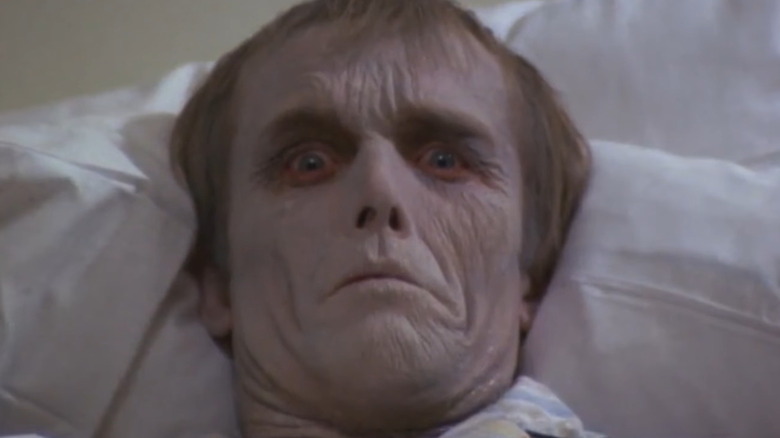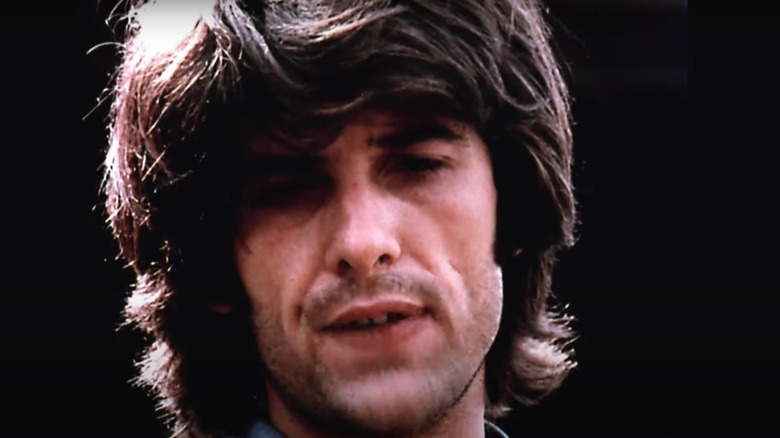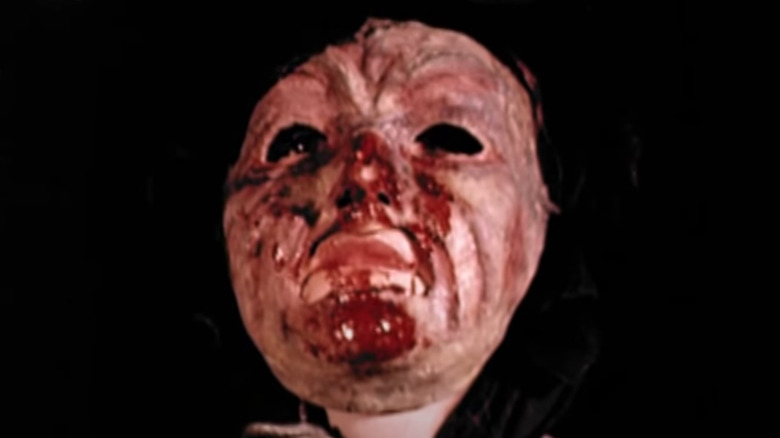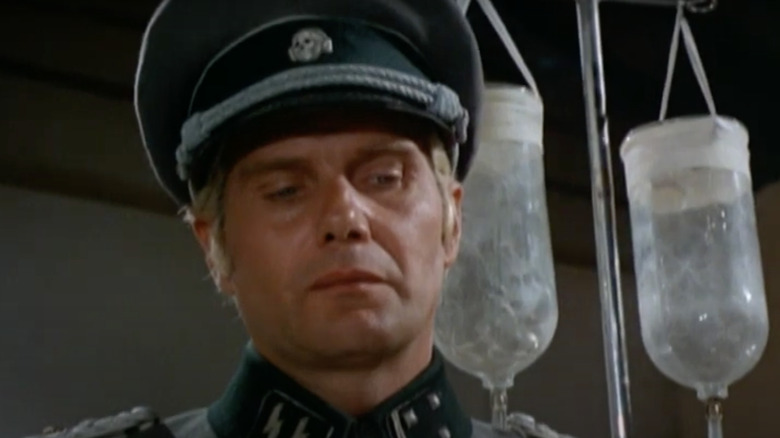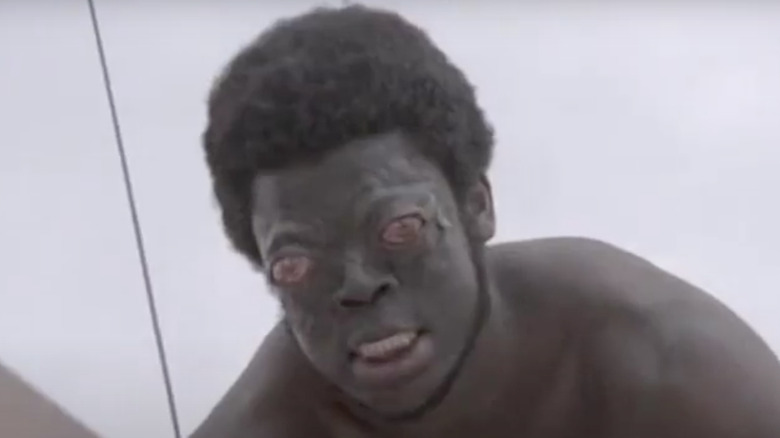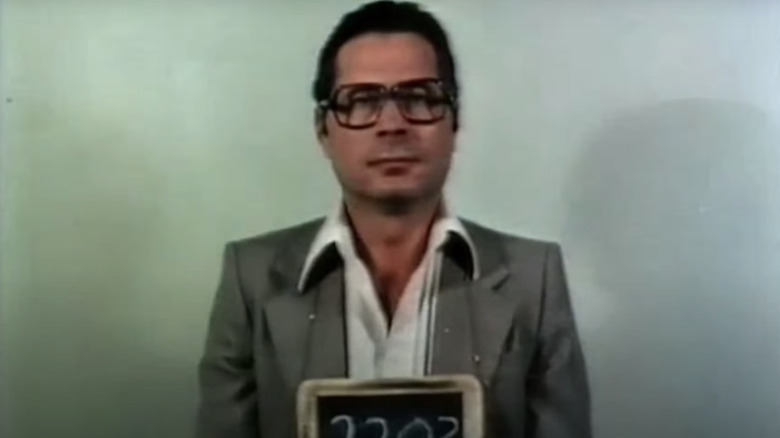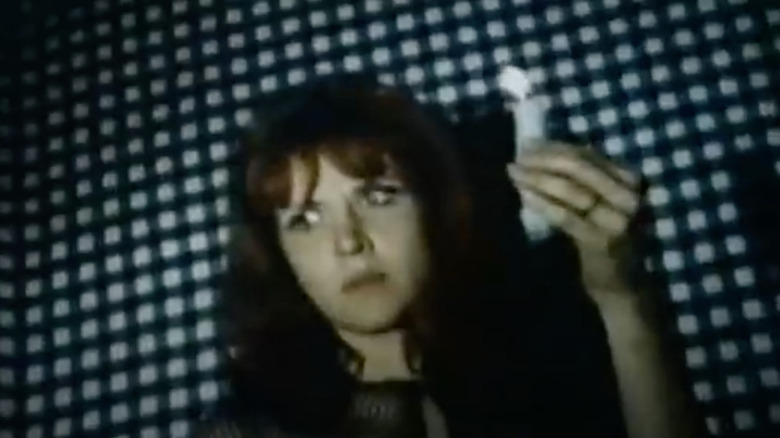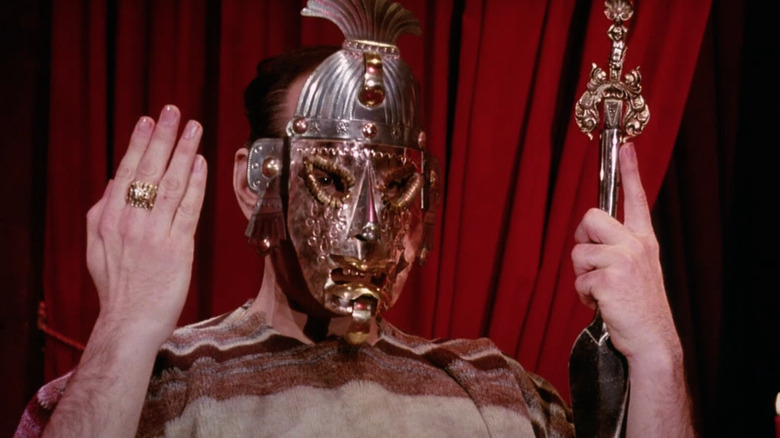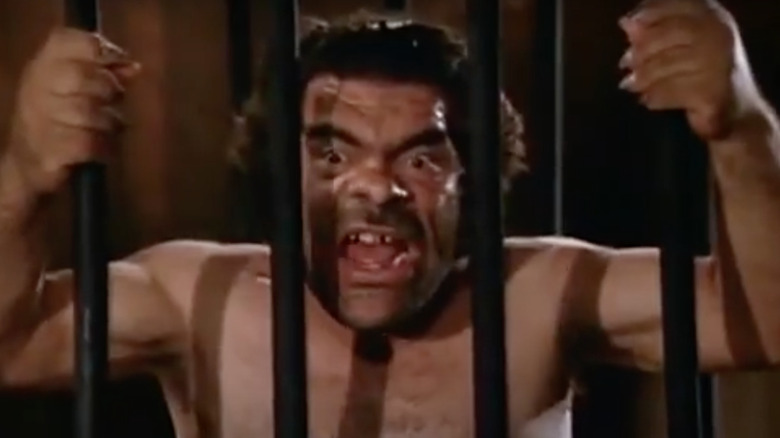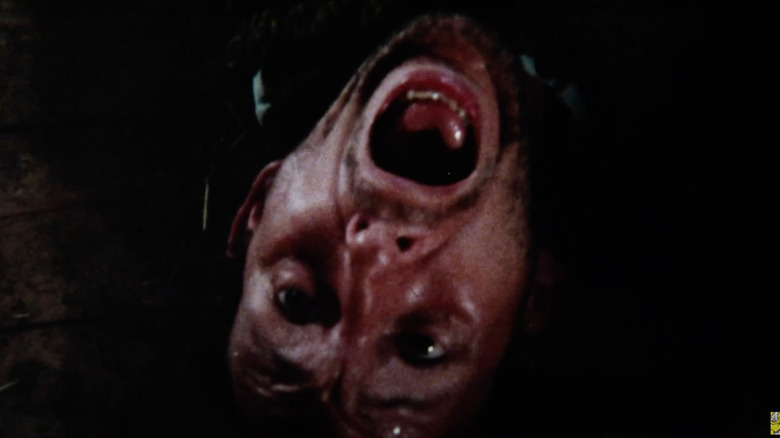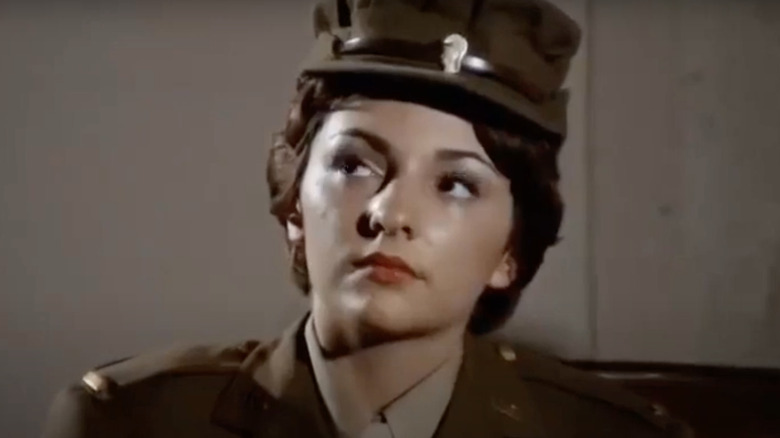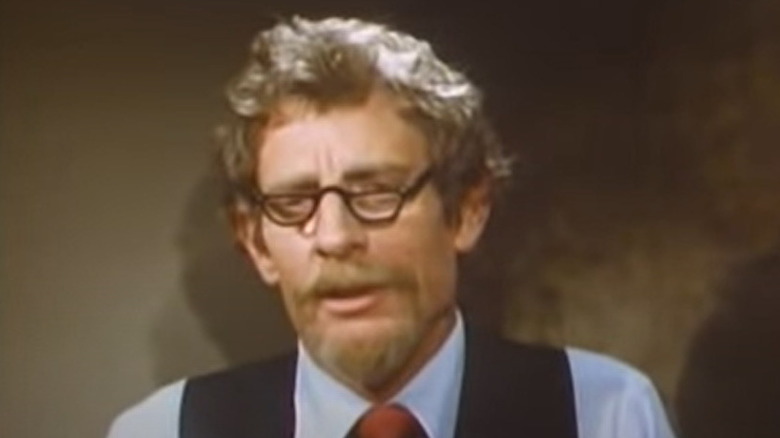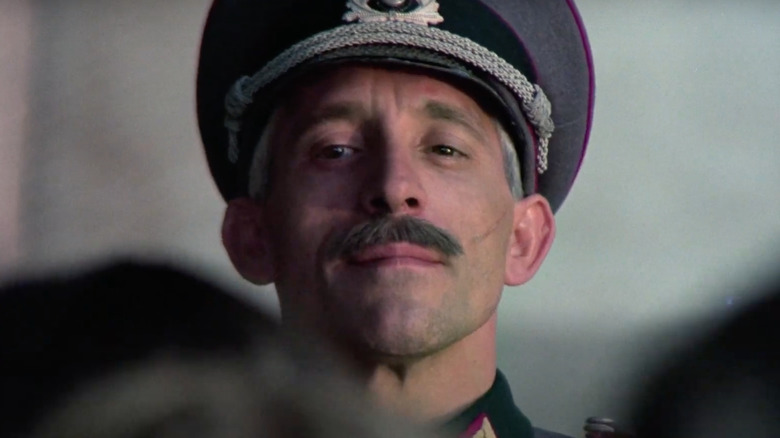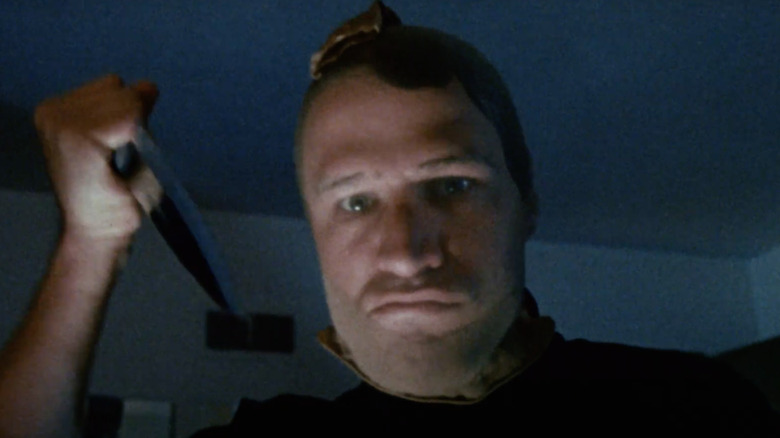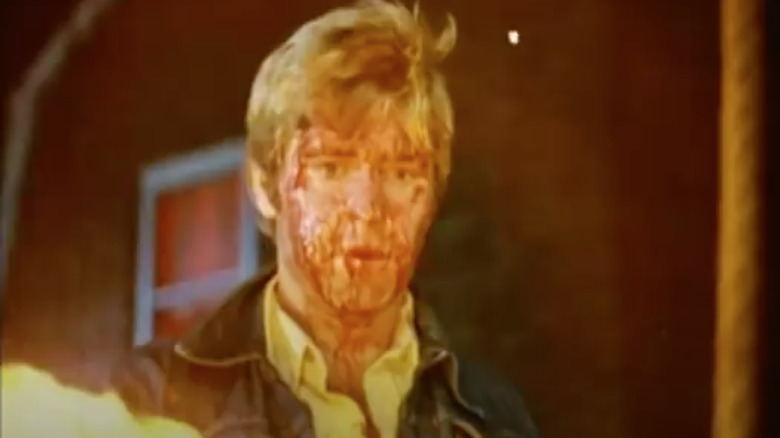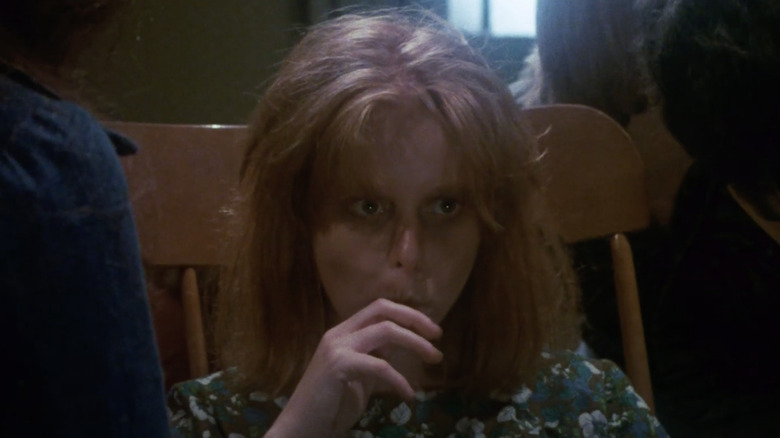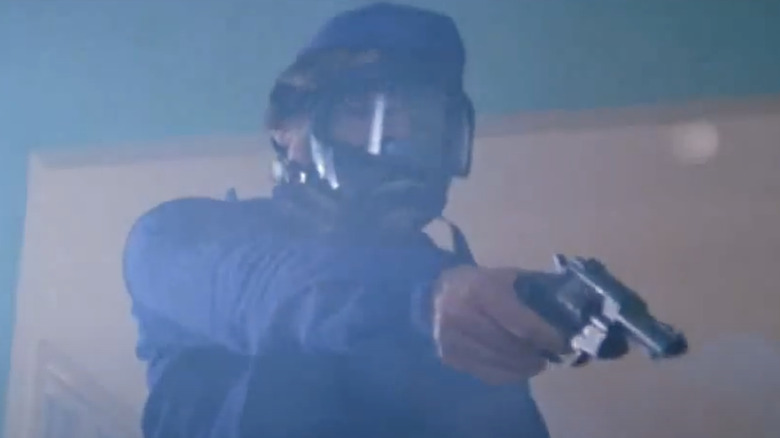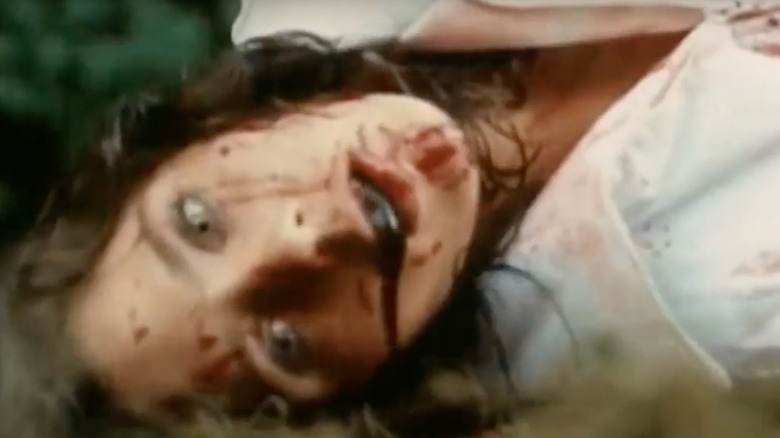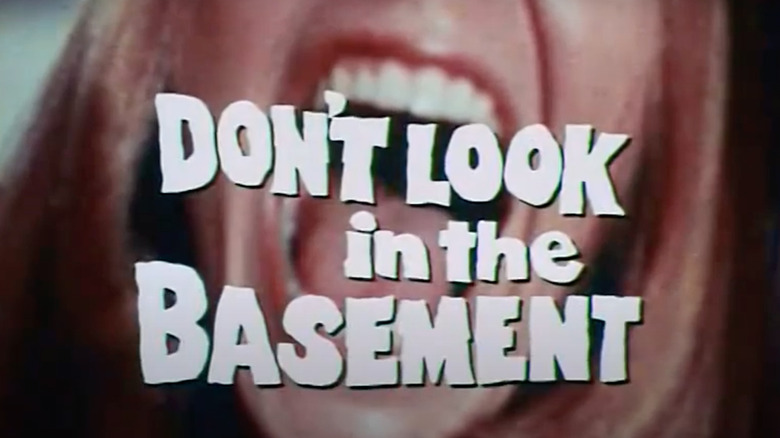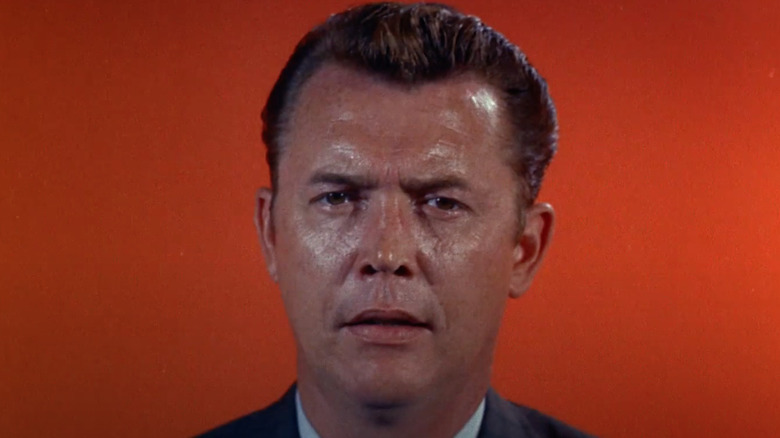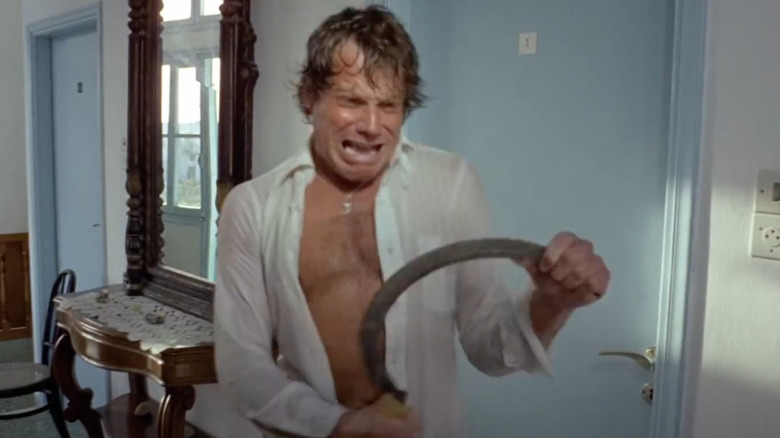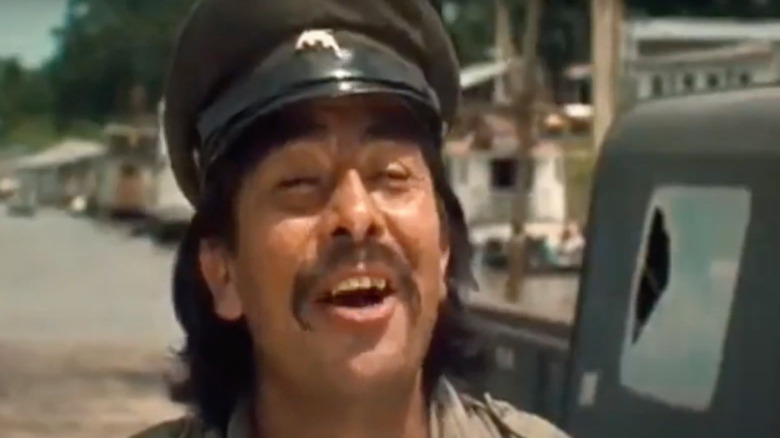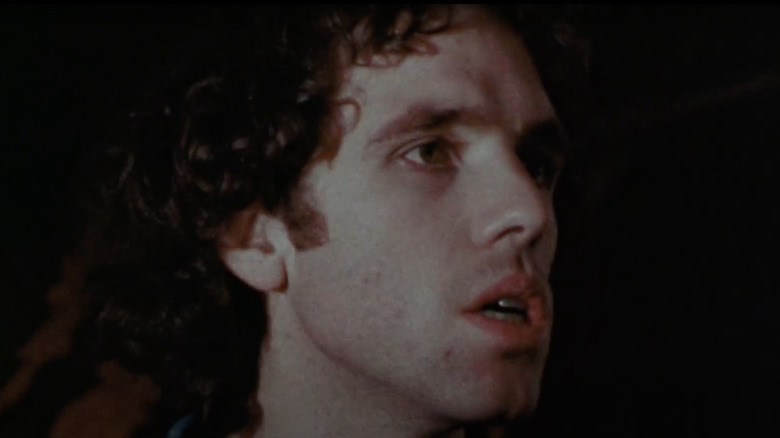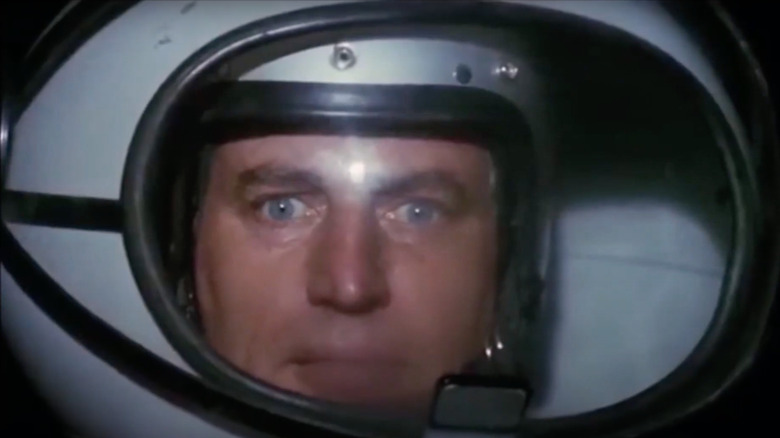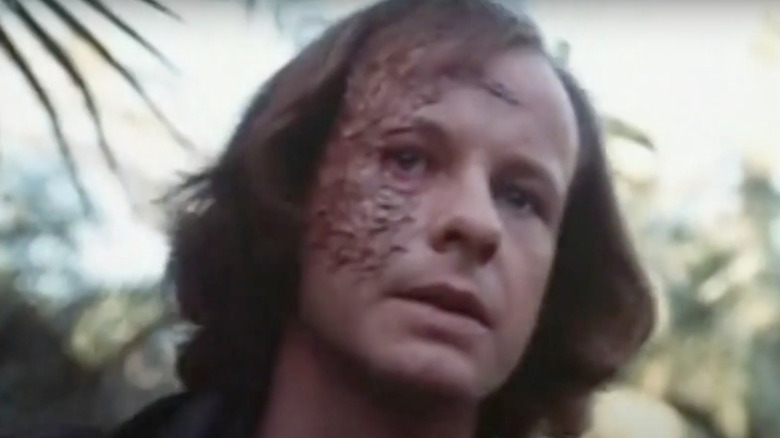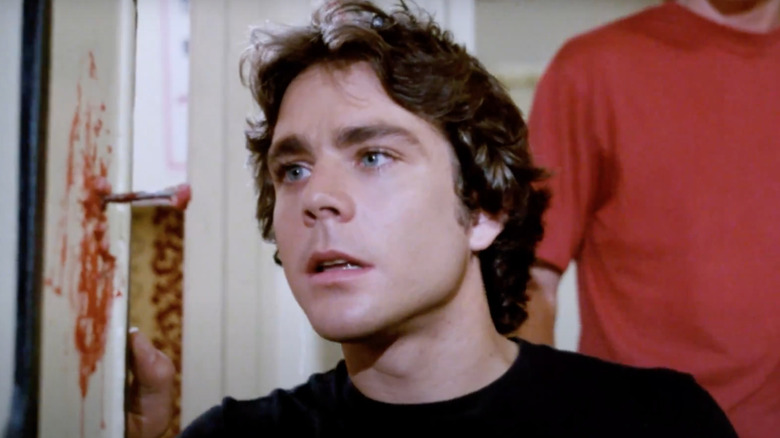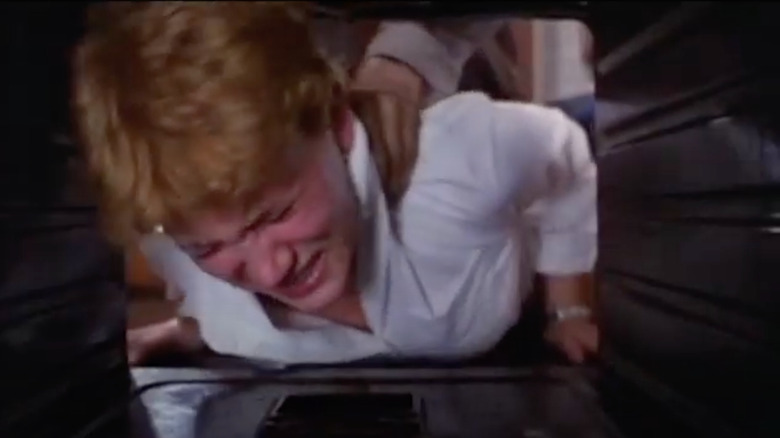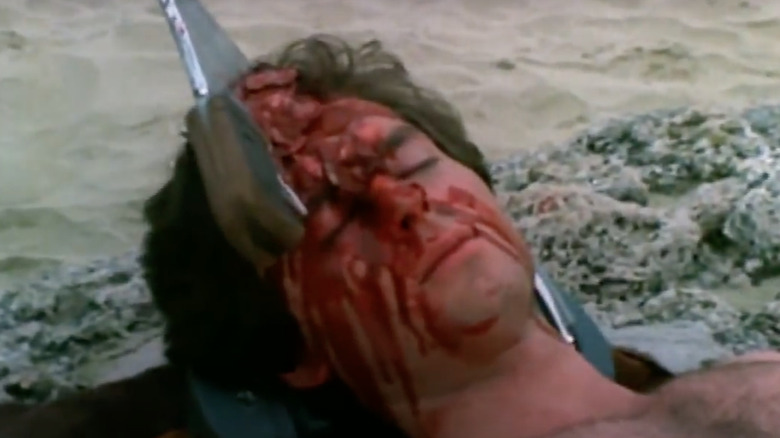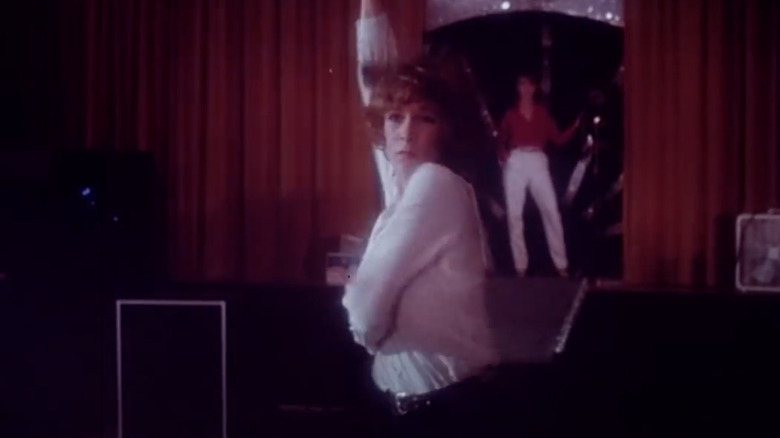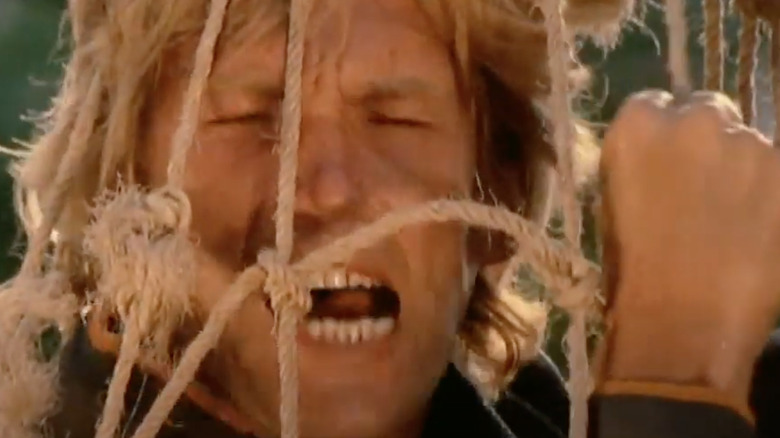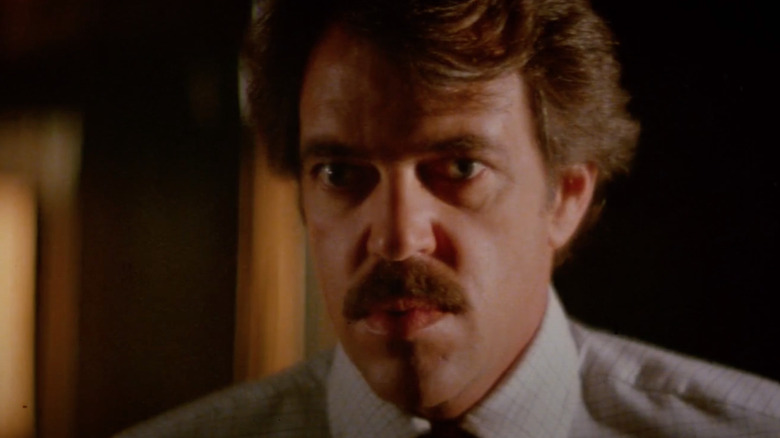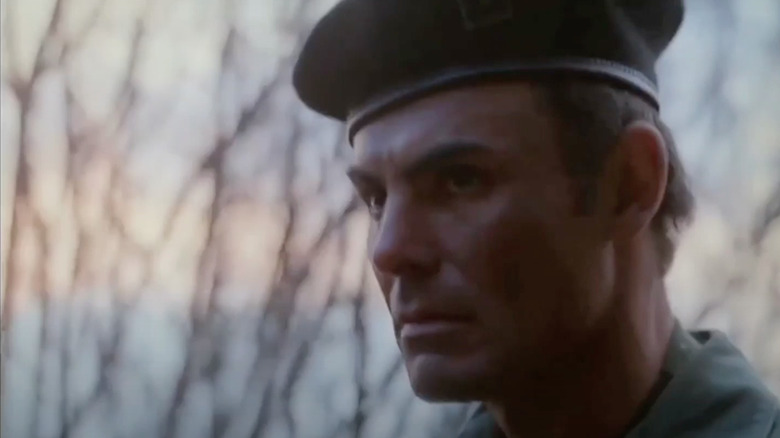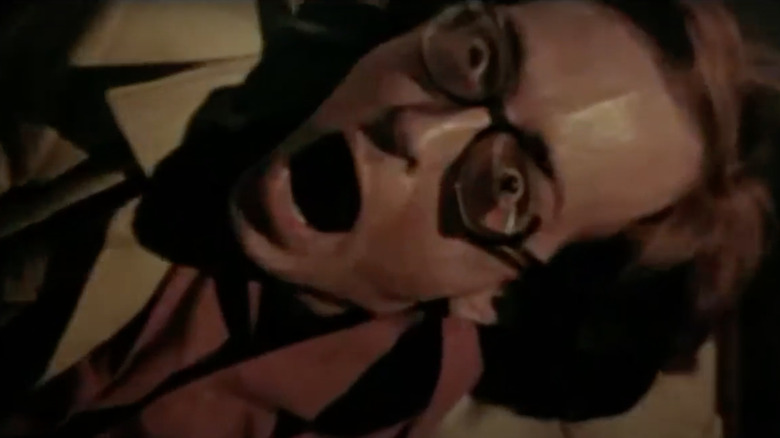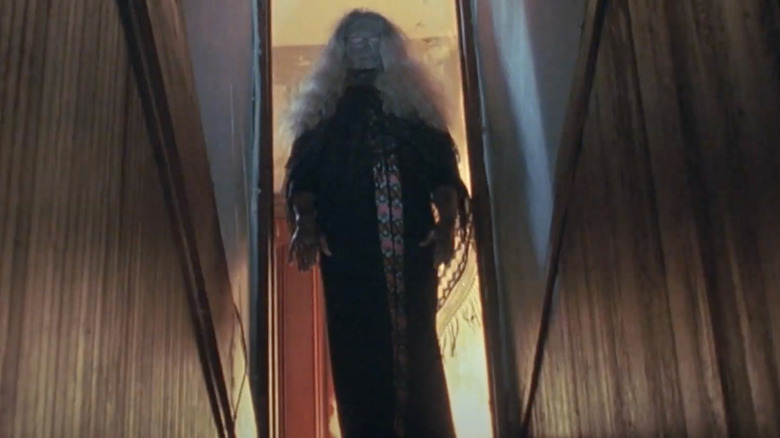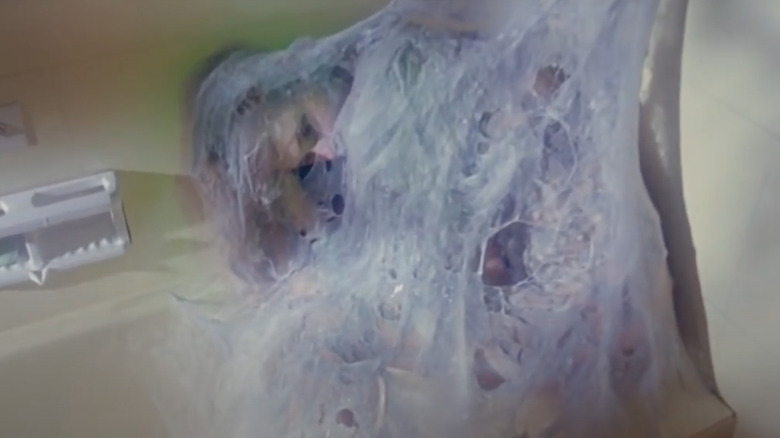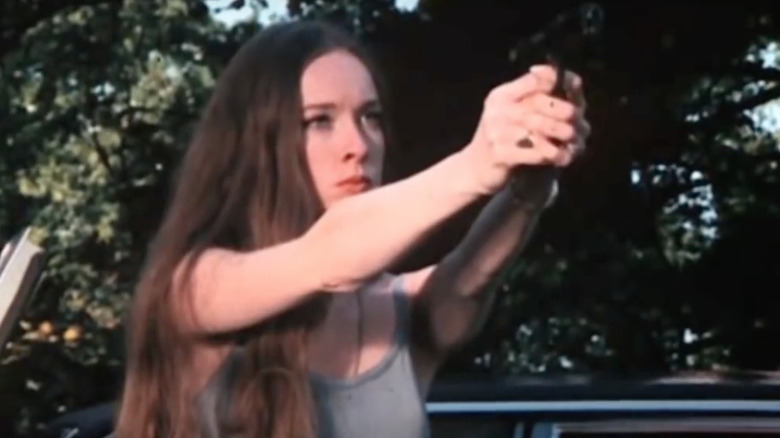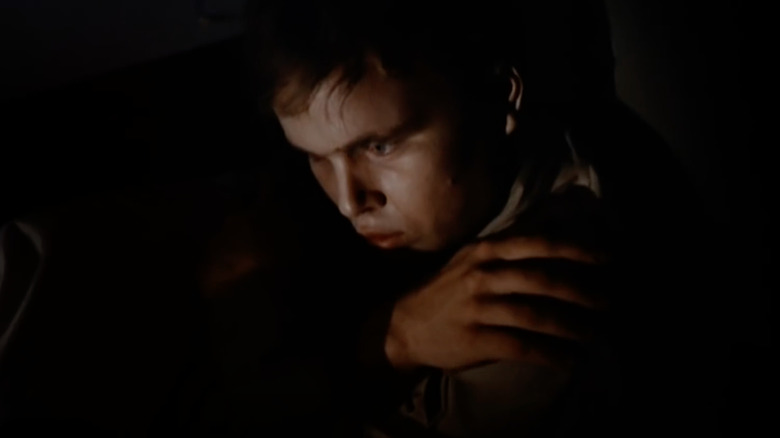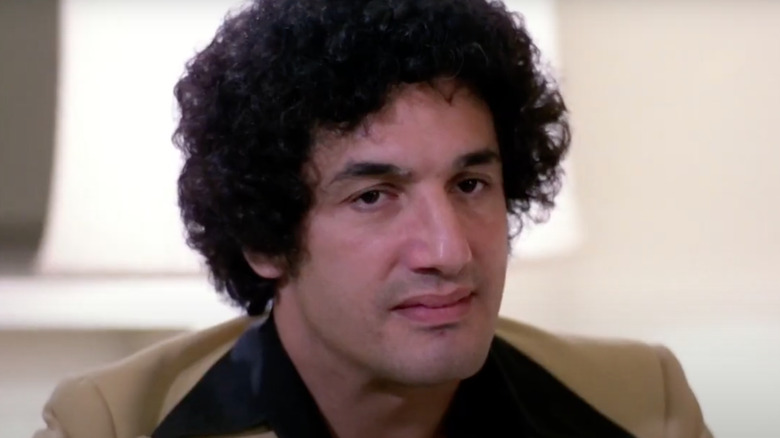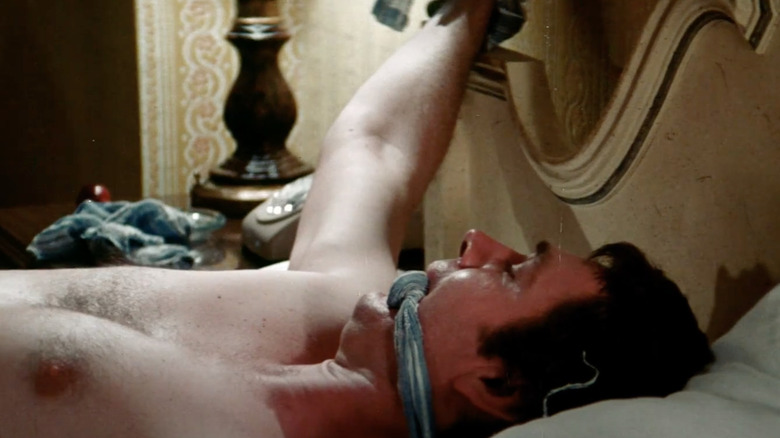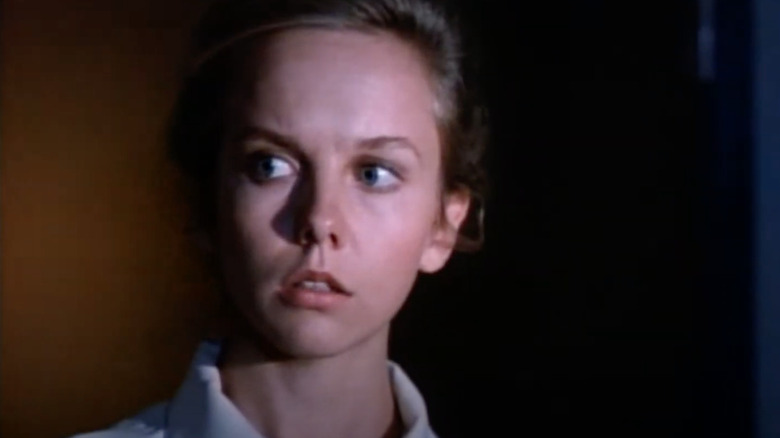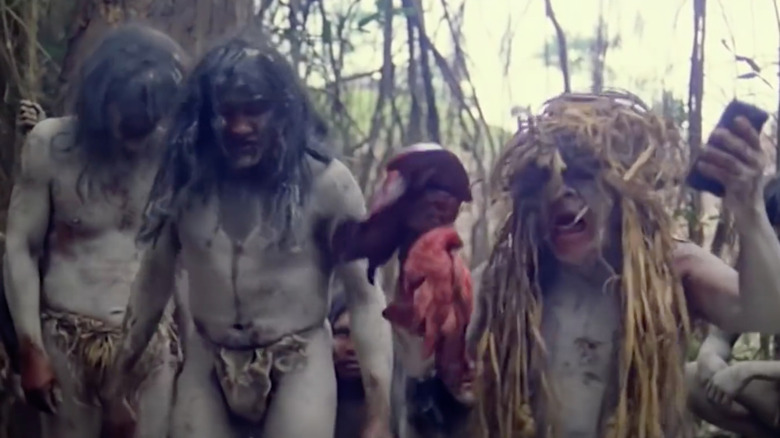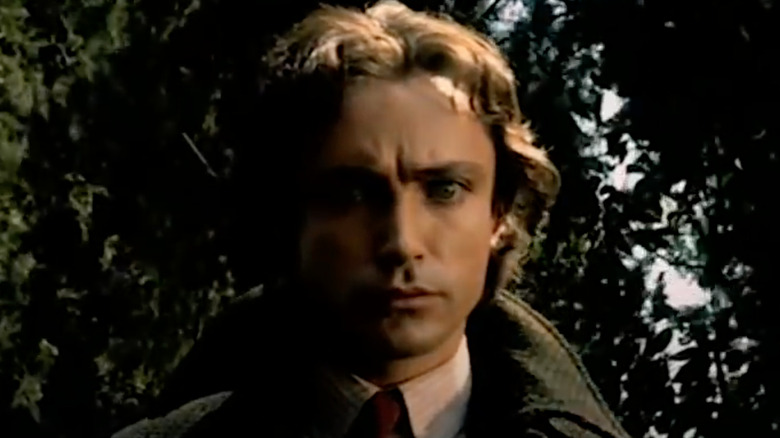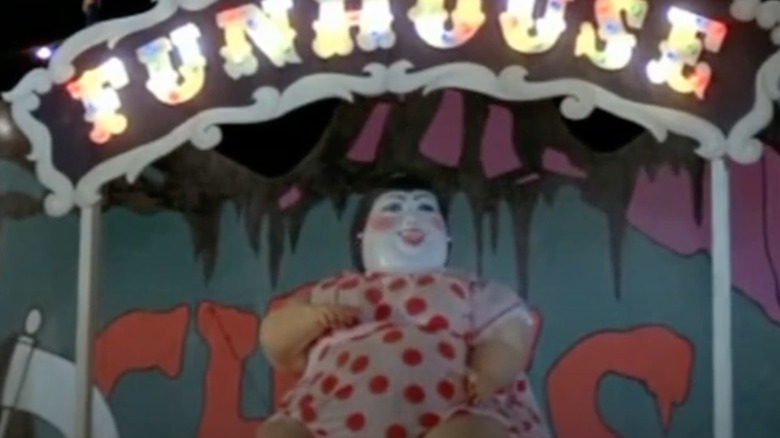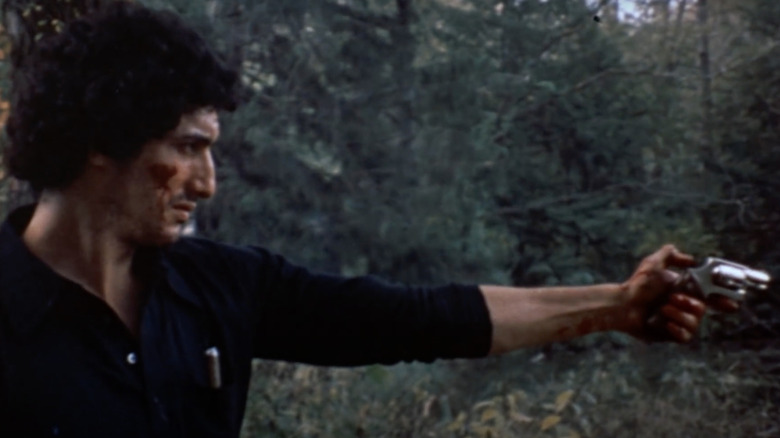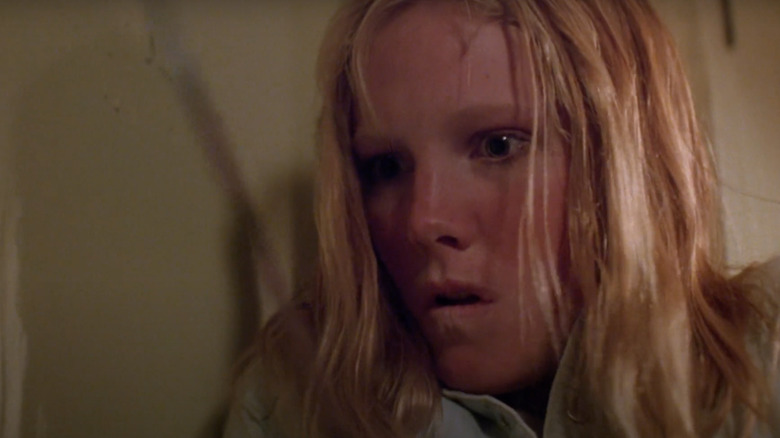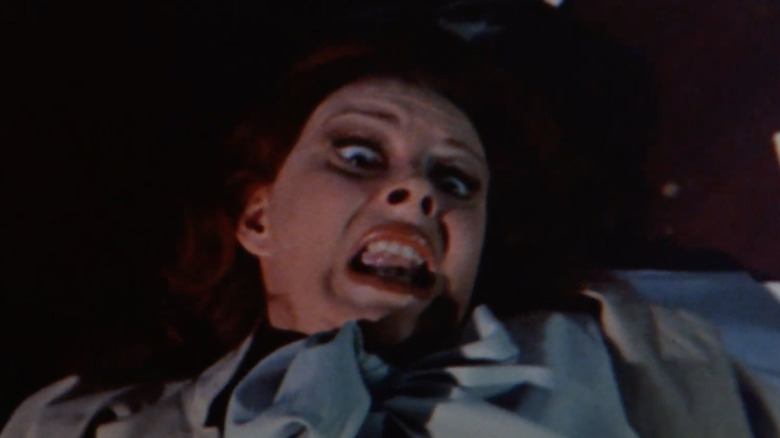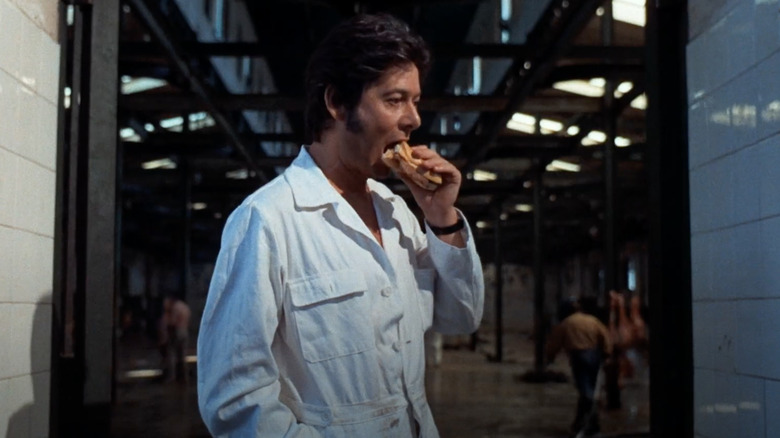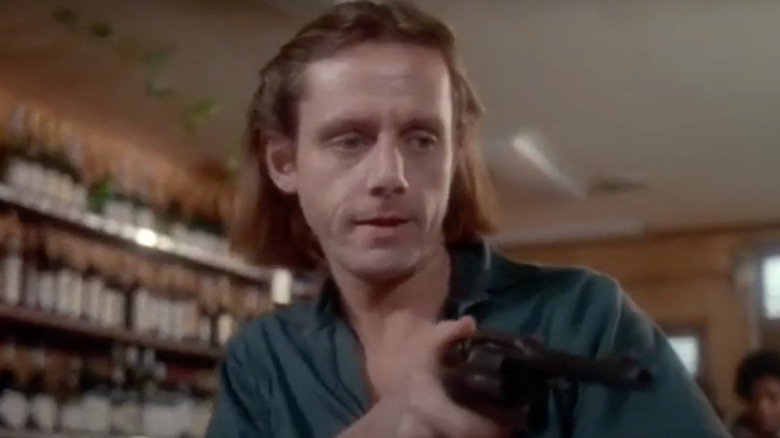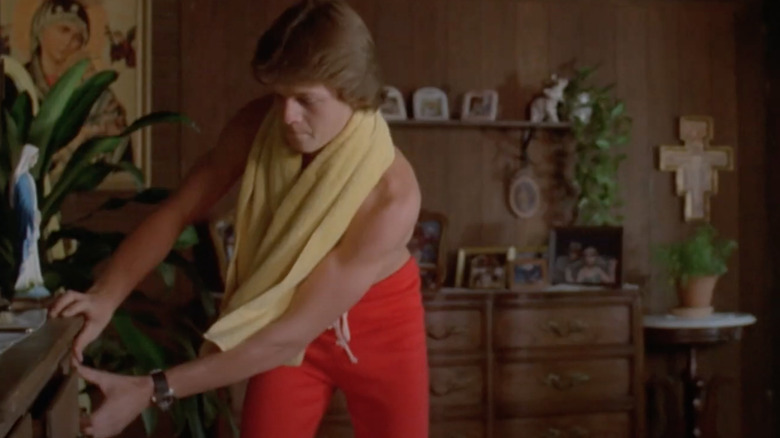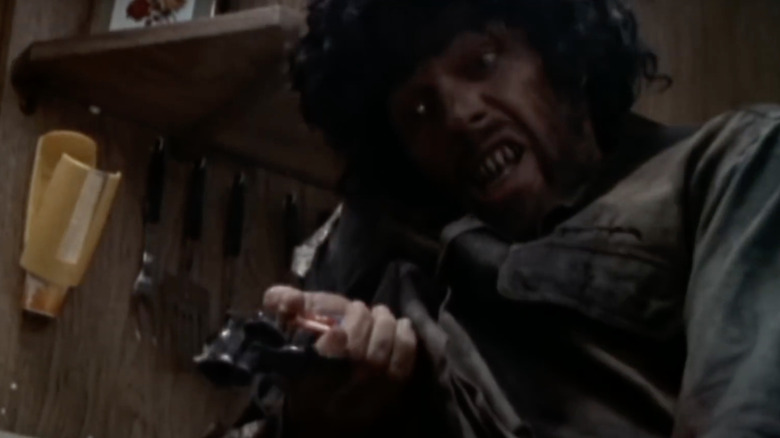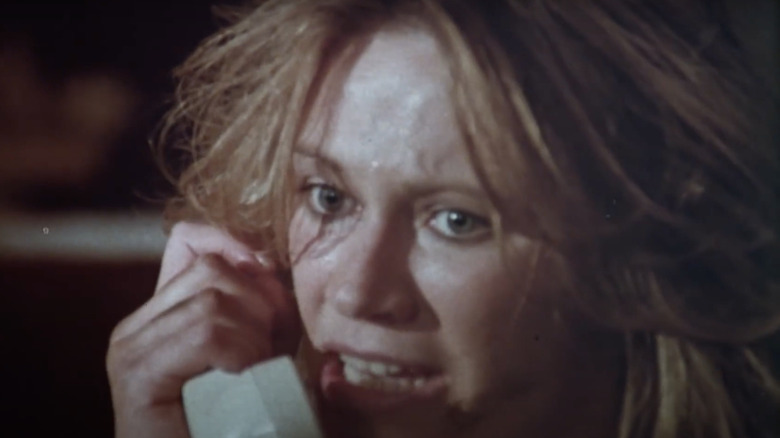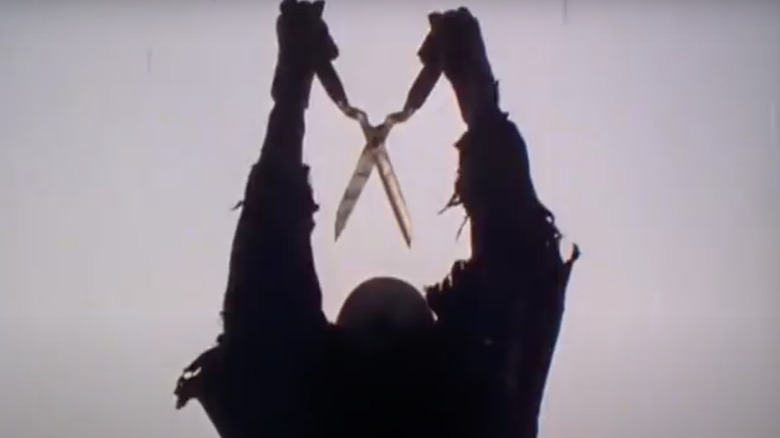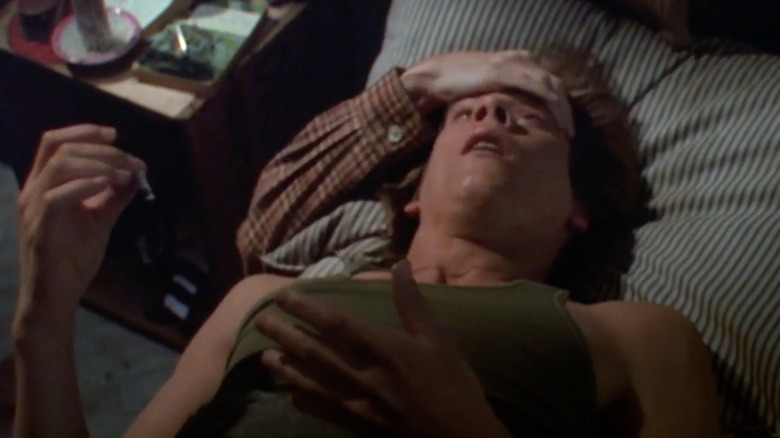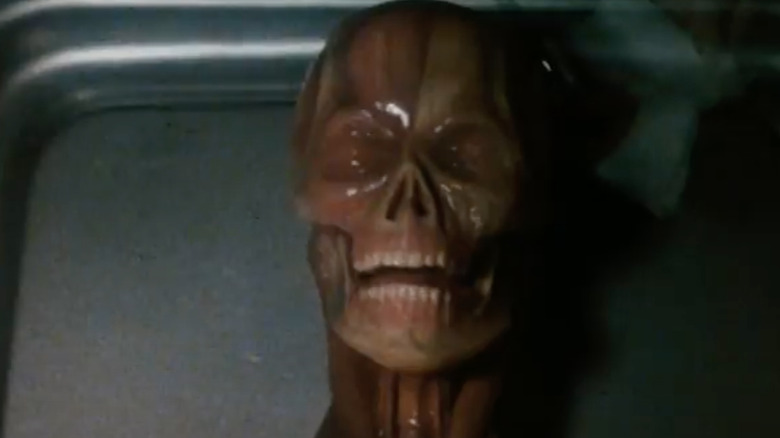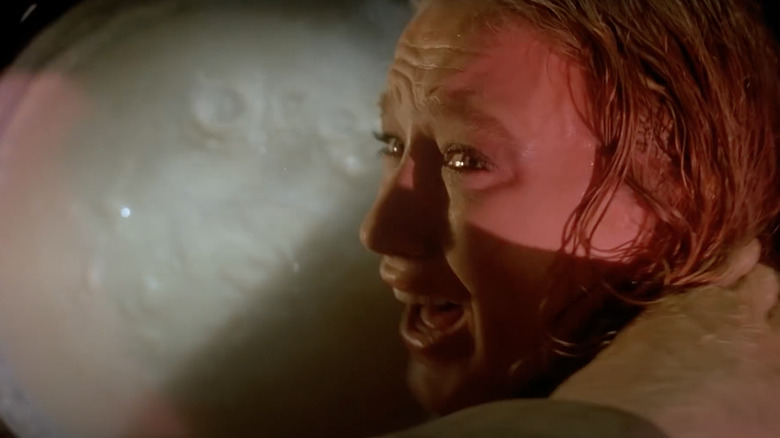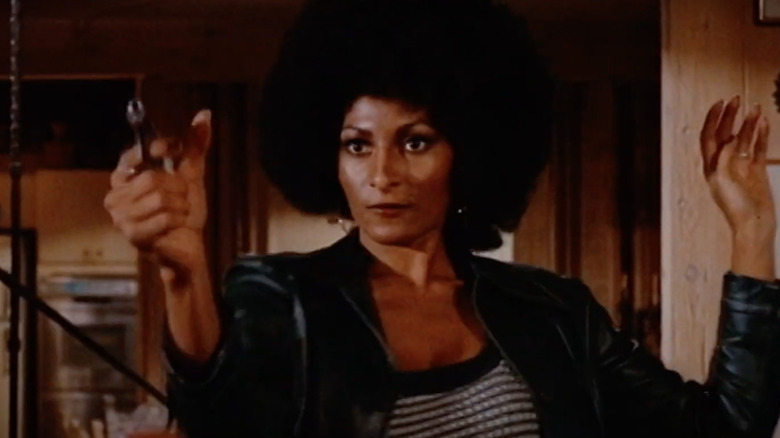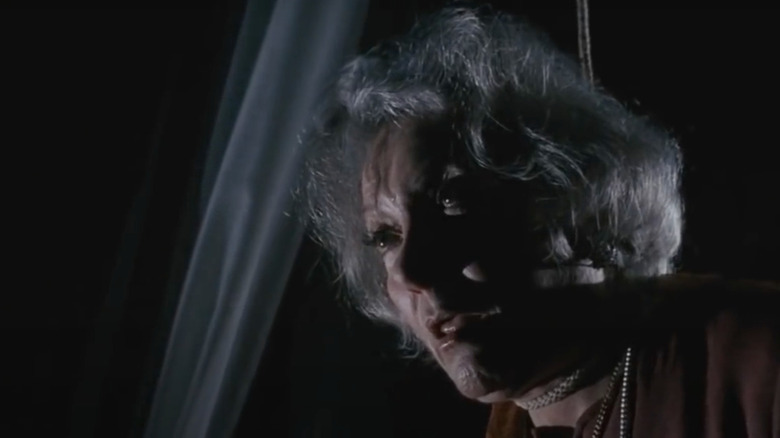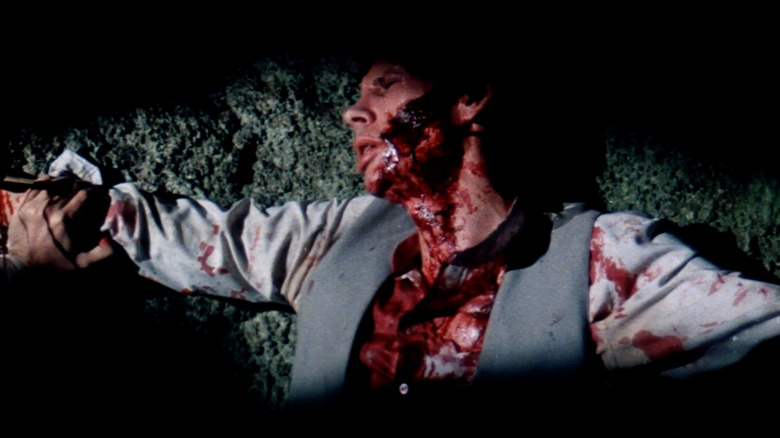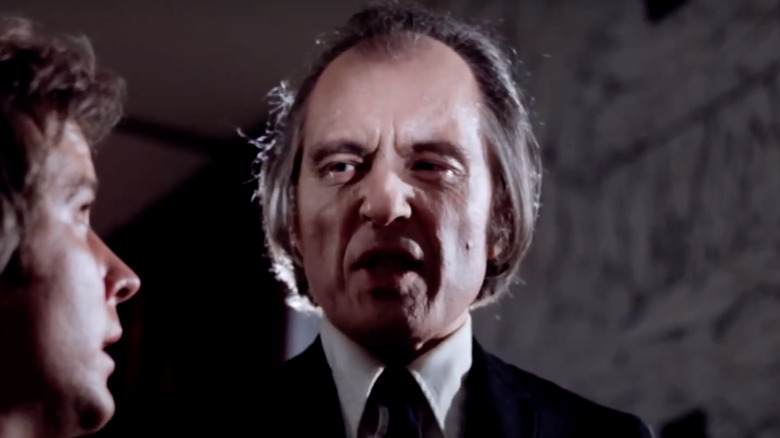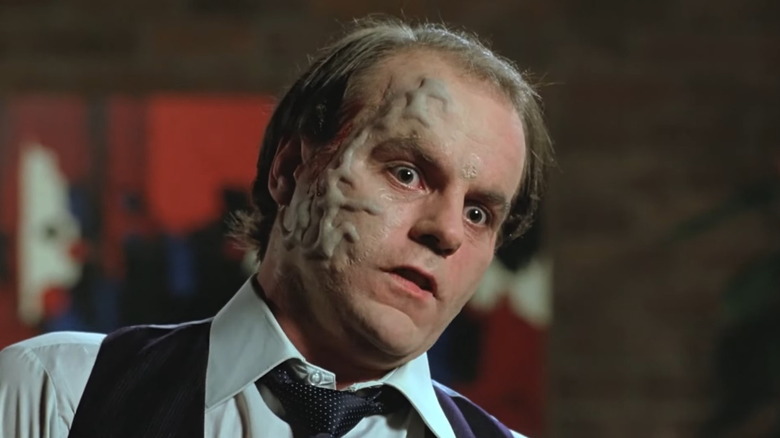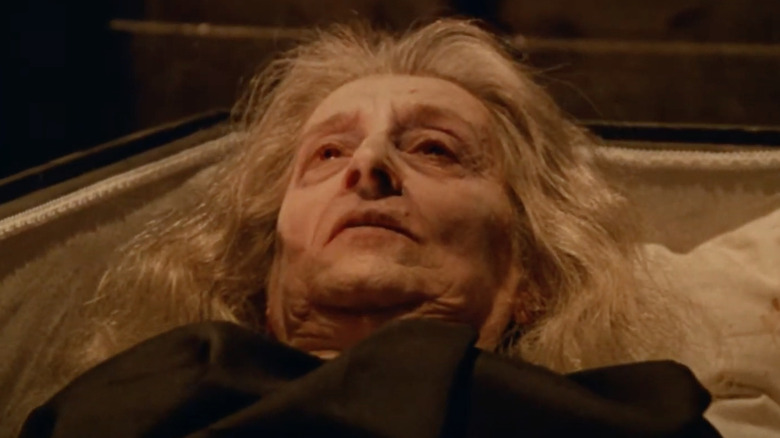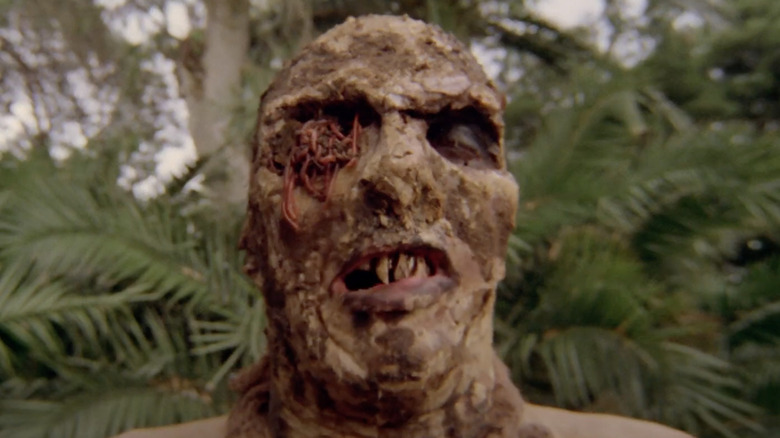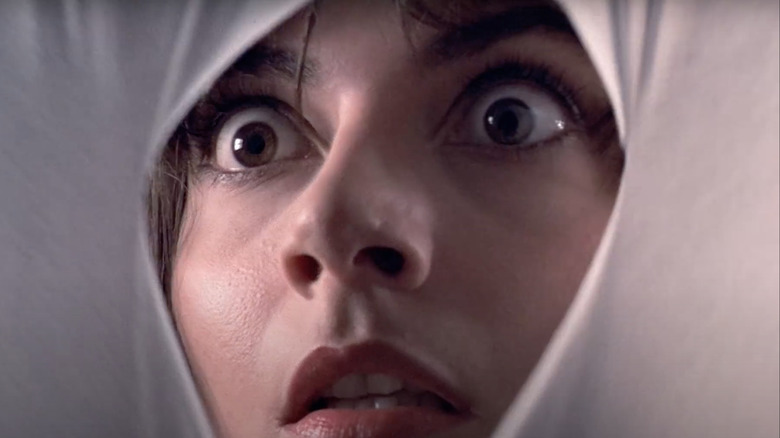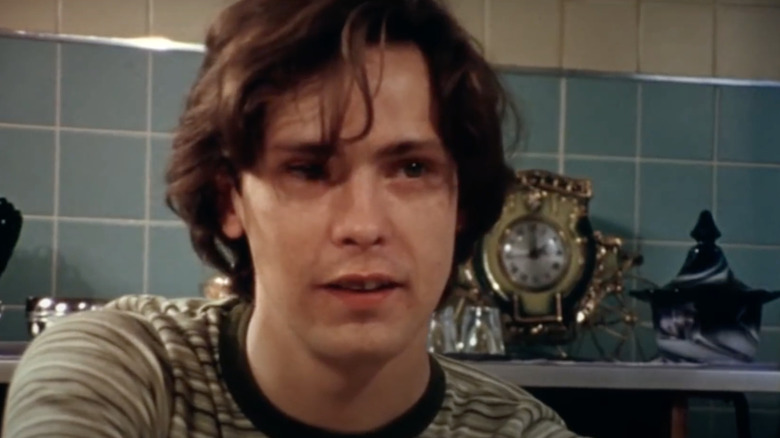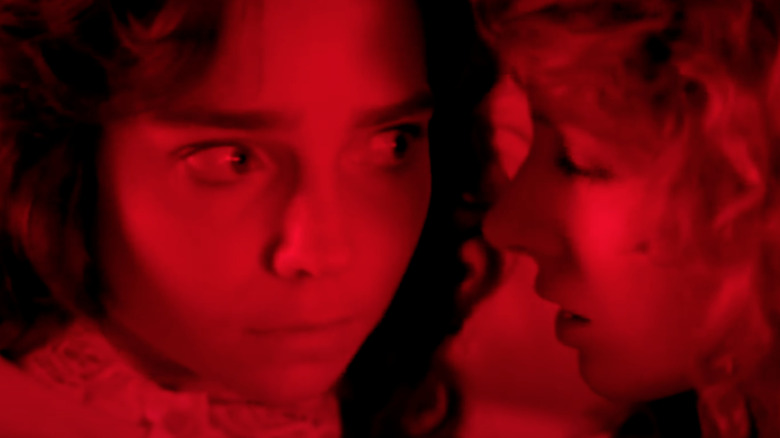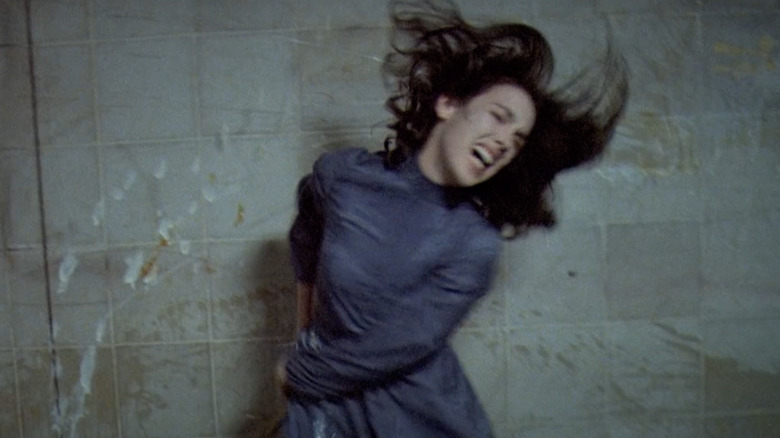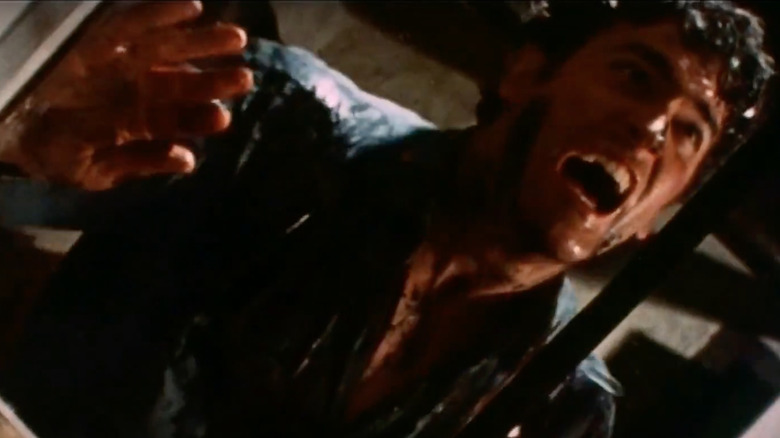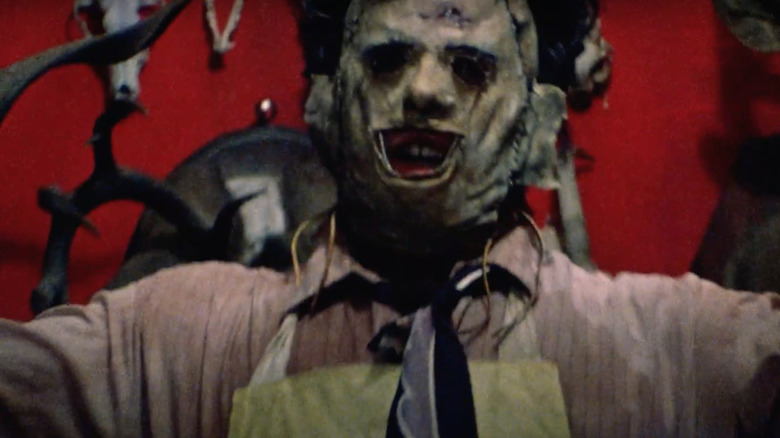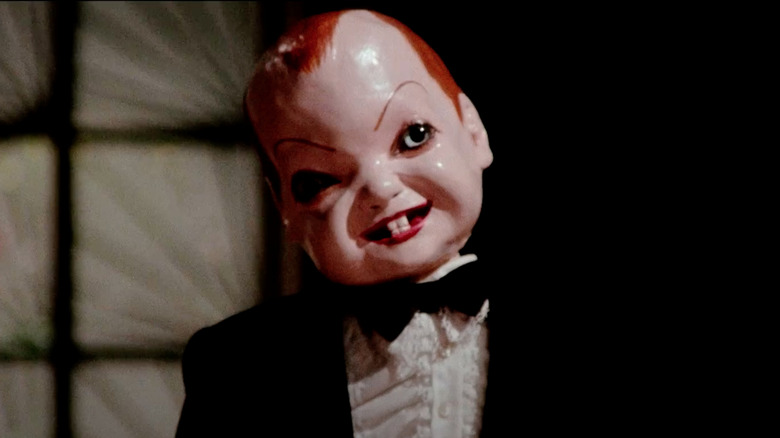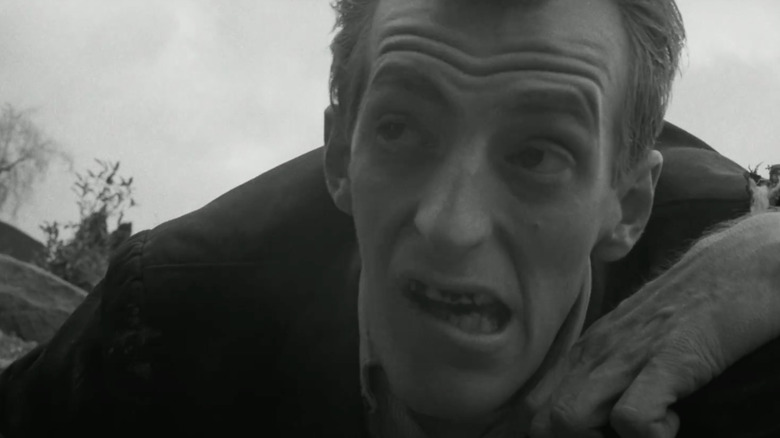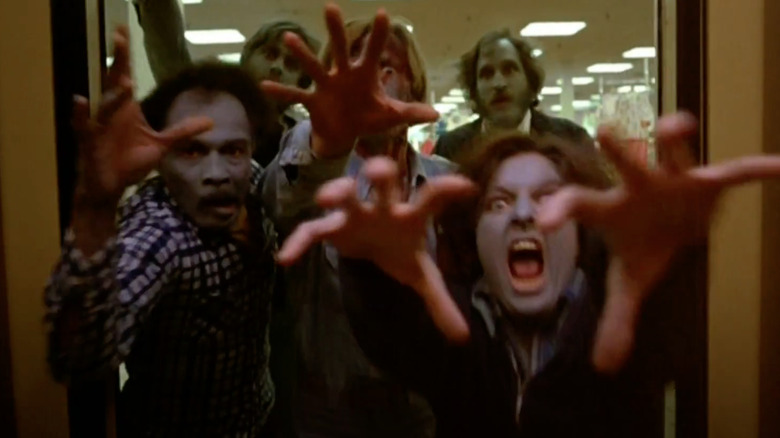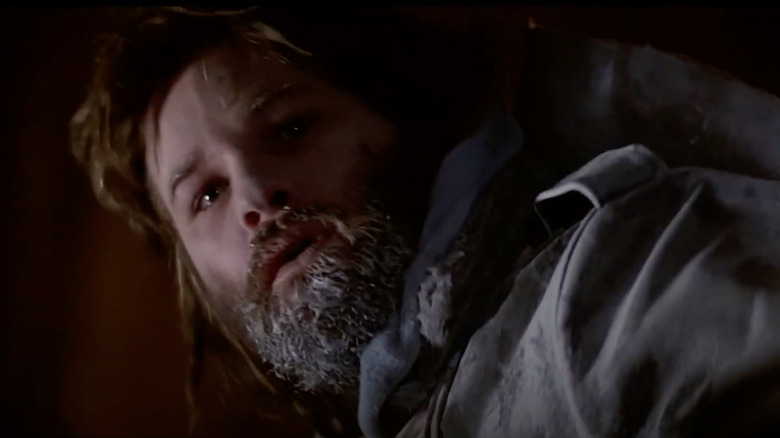Every Video Nasty Ranked From Worst To Best
Since 1857, the United Kingdom has been subject to the Obscene Publications Act. This act, revised in 1959 and amended several times since, outlaws any media that's deemed obscene, allows law enforcement to search for, seize, and destroy so-called obscene materials, and allows for anyone connected to obscene materials to be prosecuted.
According to the British Board of Film Classification, aka. the BBFC (the United Kingdom's equivalent to the MPAA), home video recordings such as VHS tapes first become a standard in the United Kingdom in 1978. At first, home video tapes were completely unregulated, but that soon changed when the VHS releases of controversial movies like "Cannibal Holocaust" hit British video stores. Pro-censorship activist Mary Whitehouse (who coined the term "video nasty," though she famously never watched one herself) and her group, the National Viewers and Listeners Association, spearheaded the push for legislative action. Their efforts culminated in the Video Recordings Act of 1984. This act led to tighter censorship and age restrictions of films in general but also banned and criminalized a slew of films — mostly in the horror genre. These outlawed tapes became known as the "video nasties."
Some video nasties were prosecuted, while others were simply banned. Others still were eventually released after cuts were made. Many video nasties were trashy exploitation films made to earn a quick buck and used the shock value of the video nasty label as a selling point. However, there are also many gems saddled with the video nasty label that went on to become classics. This ranking will let you know which video nasties you should avoid and which ones are worth seeking out.
72. Snuff
At the absolute bottom of the barrel of the video nasties list is the controversially titled "Snuff." This is one to be avoided at all costs. The hook of "Snuff" was that it was marketed as a legitimate snuff film — meaning that the kills on screen were purported to be footage of genuine murders.
However, it's clear that these claims of showcasing real murders are bogus and only used as a gimmick. Despite the generally poor filmmaking and obvious special effects, police investigated the movie and confirmed it to be a hoax. Over the years, other films have come along that have been purported to be or mistaken for genuine snuff films thanks to their decidedly gritty aesthetic, such as 2001's "August Underground" or 2011's "The Bunny Game," but they invariably turn about to be fiction all the same.
Beyond the intrigue and shock value of the central gimmick, "Snuff" has virtually nothing to offer on an entertainment level.
71. Don't Go Near the Park
The title of "Don't Go Near the Park" follows a popular '70s genre naming convention of turning the title into a warning. There are multiple other "Don't..." movies in the video nasty catalog, and director Edgar Wright of "Shaun of the Dead" and "Baby Driver" fame even parodied the trend in a fake trailer he directed for "Grindhouse" which he aptly titled "Don't."
Surprisingly, the story of this cheap exploitation flick begins in prehistoric times, following super-powered Neanderthals. Two siblings, played by Robert Gribbin and Barbara Pain, devour young members of their tribe and are cursed to eternal lives of cannibalism as a result. The movie then jumps 12,000 years into the future to modern-day Los Angeles, where the siblings are still eating young women. The film is a mess, with little more than cannibal violence to keep the viewer interested. The most notable aspect of the film (other than its inclusion on the video nasty list) is that it was directed and co-written by a teenager. Lawrence David Foldes was just 20 when the movie was released and 19 when he made it.
"Don't Go Near the Park" is also known by the alternate titles "Sanctuary for Evil," "Nightstalker," and "Curse of the Living Dead."
70. SS Experiment Love Camp
"SS Experiment Love Camp" was one of the earliest and most consistently condemned movies of the video nasty hysteria. It is also the first of several movies on the video nasty list that combines Nazis with gratuitous sex and nudity as part of the exploitation subgenre known as "Nazisploitation." This entry fits the mold in that it follows Nazis who commit sexual experiments on the camp's prisoners without bothering to include much in terms of a story.
More than the content of the film, it was the outrageous title of "SS Experiment Love Camp" and the accompanying inflammatory poster (which depicted a nude woman hung upside down and crucified in front of a Nazi commander's head) that earned the movie it's inclusion on the video nasty list. The BBFC later passed the film unedited, admitting that it was the title and poster that they initially objected to without watching the movie itself in the following statement: "The content of the film is in fact very mild and poorly executed. If anything, it was the title of the film and its original packaging that led to difficulties, rather than the content."
If you or anyone you know has been a victim of sexual assault, help is available. Visit the Rape, Abuse & Incest National Network website or contact RAINN's National Helpline at 1-800-656-HOPE (4673).
69. Devil Hunter
"Devil Hunter," also known as "The Man Hunter," "The Cannibal," and most provocatively of all, "Sexo Cannibal," follows a Vietnam vet who attempts to save a woman from an island full of cannibals and their demonic god. The movie was directed by Jesús Franco, a name that is likely unfamiliar to the general public but that hardcore horror fans might recognize. Franco had a few breakthrough movies in the genre such as his faithful version of Bram Stoker's classic novel, "Count Dracula," which features Christopher Lee in the titular role outside of the Hammer "Dracula" movies that he was best known for and Klaus Kinski nearly a decade before he was cast as Dracula in Werner Herzog's "Nosferatu the Vampyre."
Franco made more than 300 movies throughout his 56-year career under dozens of pseudonyms ranging from Candy Coster to Roland Marceignac. "Devil Hunter" was one of six movies Franco released in 1980. In addition to having a number of his films included on the video nasties list, Jesús Franco also rankled the Catholic Church, which named him one of the most dangerous filmmakers in the world.
68. Drop Dead Dearest
"Drop Dead Dearest," which is also known by the title "I Miss You, Hugs and Kisses," is a 1978 Canadian mystery thriller about a millionaire (Donald Pilon), who is accused of murdering his wife (Elke Sommer). The film teases whether or not he is guilty, but any knowledge of the high-profile real-life murder case that the story was based on (which took place only a couple of years before the movie was made) removes any sense of mystery. The Peter Demeter murder case served as the basis for this fictionalized movie murder. The case became famous for being the longest court trial in Canada's history and for bizarre details like a murder-for-hire scheme with a never-identified perpetrator and the allegation that Demeter's wife was planning to murder him at the same time he had her killed by a hitman.
If the movie were a straightforward adaptation of the real murder trial, it is unlikely that it would have been placed on the video nasty list. The execution of the marquee murder scene is gratuitous, but writer-director Murray Markowitz also added boatloads of violence, nudity, and even necrophilia inflicted upon a murdered schoolgirl. Though the movie was banned in the United Kingdom upon its initial release in 1978, "Drop Dead Dearest" was eventually released eight years later after about a minute's worth of cuts were made to appease the censors.
67. The Ghastly Ones
Although the video nasty hysteria kicked off in the '80s after the passage of the Video Recordings Act, the tightened grip of censorship went into effect retroactively. This meant that older movies which had previously been released in the United Kingdom were now subject to tougher regulations and could be prosecuted. Such was the case with "The Ghastly Ones," which originally enjoyed an unfettered release in 1968.
The story follows three sisters (and their husbands), who are determined to inherit a large home belonging to their recently deceased father. Inheriting the home means spending three days and nights within it as a requirement of the will, but a deranged killer is in the house with them. What follows is a series of gruesome murder scenes in which the characters are killed off one by one in low-budget, gory fashion. The most outrageous scene involves a mentally challenged man eating live rabbits, which has nothing to do with the plot and is only included for shock value. Mission accomplished.
66. Mardi Gras Massacre
"Mardi Gras Massacre" is a movie that delivers on its title's promise and nothing more. The plot follows a masked killer who murders women in ritualistic fashion during the New Orleans Mardi Gras celebration. Meanwhile, the local police try to catch him but not before excessive nudity and violence comprise the bulk of the movie's runtime. The movie has a connection to another video nasty, "Blood Feast" from 1963, though the specifics of the connection are hazy. "Mardi Gras Massacre" is often labeled as a semi-sequel to "Blood Feast," but is also sometimes referred to as a remake or simply a rip-off of "Blood Feast."
For many years, "Mardi Gras Massacre" was banned in the United Kingdom and unrated in the United States after refusing to accept an X rating from the MPAA. It was only in 2022 that "Mardi Gras Massacre" was finally released in the United Kingdom, fully uncut.
65. SS Hell Camp
"SS Hell Camp" is another entry in the Nazisploitation subgenre. The movie was released under myriad alternate titles, including "SS Camp 5: Women's Hell," "The Beast in Heat," and "Horrifying Experiments of SS, Last Days." "SS Hell Camp" was an extremely cheap production that utilized the same cast and leftover sets from "SS Experiment Love Camp" released one year earlier. Both movies were made by Italian filmmaker Sergio Garrone, who was earlier known for directing multiple movies in the "Django" spaghetti Western series.
"SS Hell Camp" and "SS Experiment Love Camp" follow similar plots. They're practically the same movie. The biggest thing that sets the two apart is the fact that the goal of the Nazi experiments this time around is to turn the male prisoners into sex-crazed man-beasts, and you better believe they find some success. The sex beast is fed a diet of aphrodisiacs and used as a tool to sexually torture the female prisoners. "SS Hell Camp" is a bit more depraved than the earlier Nazisploitation flick that it shares much of its production elements with. It remains banned in the United Kingdom to this day, though it is available for viewing in the United States completely uncut.
64. Toxic Zombies
Many video nasties had titles or alternate titles that had very little to do with the actual content of the movie, and "Toxic Zombies" is one such example. This is not quite the zombie movie that the title implies, though it does involve plenty of mindless flesh-eating. When a cropduster drops a new formula, those who inhale the chemicals turn into insatiable cannibals. The movie has plenty of alternate titles that do not include the word "zombie" such as "Bloodeaters," "Blood Butchers," "Forest of Fear," and "Crying Fields."
In addition to starring in the film, Charles McCrann also wrote, directed, produced, and edited "Toxic Zombies." It was the only movie of his career. "Toxic Zombies" was one of the video nasties which was successfully prosecuted under the Video Recordings Act and was outright banned in the United Kingdom with no cuts being made to secure a release. After being hard to track down for many years, a 4K restoration of the movie was released on Blu-ray in 2021 through the Massacre Video label.
63. Love Camp 7
Released in 1969, "Love Camp 7" predates most movies of its ilk and just might be responsible for kickstarting the entire Nazisploitation subgenre that followed throughout the 1970s. Being the first doesn't necessarily mean that "Love Camp 7" is all that much better than the other Nazisploitation flicks, but it does at least have a bit more going on in its plot than just gratuitous sex and torture. Not much more, but a little bit more.
The story follows Grace Freeman and Linda Harman (played by Kathy Williams and Maria Lease), two Allied army lieutenants who are sent undercover into the titular "Love Camp 7," a Nazi prison camp. Their mission is to locate and escape with intelligence that could turn the tide of the war, but when their cover is blown, they are subjected to sexual torture as punishment. Kickstarting its own subgenre is hardly a good thing when the subgenre in question is Nazisploitation. Even the most famous Nazisploitation movie, "Ilsa: She Wolf of the SS," which is typically considered the pinnacle of the subgenre, just barely ekes out a positive 5.1 score on IMDb, with nearly every other entry in the subgenre receiving negative scores.
62. Faces of Death
"Faces of Death" was the movie singled by Siskel and Ebert in their report on video nasties. Gene Siskel called it the most popular video nasty among American teens, lambasting it as "truly disgusting" and "a piece of trash." Nevertheless, the movie was a hit, and "Faces of Death" became a full-fledged series with six installments over the course of about two decades, plus a few extra compilation releases.
There is absolutely no plot in "Faces of Death," nor are there any real characters. The movie is nothing more than a collection of various shots of dead bodies or of people or animals dying. Despite having many fabricated scenes, the movie presents itself as a documentary, suggesting that everything in it is 100 percent real. This claim brings the movie into the subgenre of mondo films. Also known as shockumentaries, these films are grotesque exploitation documentaries that revolve heavily around animal cruelty and death.
Many, including Gene Siskel, suspected that the claims that everything in "Faces of Death" was real was merely a gimmicky selling point. As covered by The Guardian, the film's creator eventually revealed that some of the death sequences were staged to fill out the runtime, but that much of the content was real, including footage he shot of genuine autopsies and executions and graphic clips of suicides and deadly accidents he purchased from television station news archives.
If you or anyone you know is having suicidal thoughts, please call the National Suicide Prevention Lifeline by dialing 988 or by calling 1-800-273-TALK (8255).
61. The Gestapo's Last Orgy
"The Gestapo's Last Orgy" is a 1977 entry into the surprisingly large Nazisploitation subgenre. It was also released at various times under the alternate titles of "Last Orgy of the Third Reich" and "Caligula Reincarnated as Hitler." The film uses a non-linear structure to tell the story of a Jewish woman (Daniela Poggi) who returns to what remains of the concentration camp where she was held captive. Through a series of prolonged flashbacks, viewers are shown the horrors she faced in graphic detail.
This movie was among those that were successfully prosecuted under the Video Recordings Act and has remained banned in the United Kingdom ever since. In 2021, a push was made to finally get the BBFC to pass the film, but the organization outright rejected the film. The BBFC declared the film "unsuitable for classification," citing that sadistic violence, constant non-consensual sexual activity, and antisemitic overtones constituted the bulk of the movie. Their official statement on the matter of passing the film was: "The sadistic and sexually abusive material it contains is too pervasive to be effectively addressed by cuts. Accordingly, the BBFC has refused classification to this work."
60. Delirium
"Delirium," also known as "Psycho Puppet," is a 1979 vigilante movie that earned an infamous reputation for reveling in indiscriminate violence and bloodshed. The story follows a Vietnam War veteran (Nick Panouzis in the only movie of his career), who gets roped into acting as a weapon on behalf of an underground vigilante council. This council is bent on cleaning up the city, with little thought as to what that actually means beyond killing members of the public that they don't like. The war vet's intense PTSD has rendered him nothing more than a psychotic killing machine who would be stalking the streets and murdering people anyway, so he is happy to do the vigilante council's bidding. The council is happy with his performance at first, but he eventually begins killing them off, too, and they realize they should fear the monster they have created.
As covered by Dread Central, "Delirium" was cobbled together when director Peter Maris took the unfinished footage of an unnamed conspiracy thriller and shot new scenes to complete the package. After being banned and unavailable outside of rare VHS copies, Severin Films eventually released the movie uncut on Blu-ray in 2022.
59. The Boogeyman
"The Boogeyman" is a supernatural horror movie from 1980. The movie was directed by Ulli Lommel, who had a notorious reputation for being the #1 lowest-scoring filmmaker on IMDb, with more than a dozen movies with scores below two stars. This film has nearly countless alternate titles, including "Spectre;" "The Black Mirror;" "Killer Force;" "The Devil's Spell;" "Terror of the Night;" "Mirror: Who Lives in that Mirror?;" "The Killer Mirror;" "Satan, the Reflection of Evil;" and most bizarrely of all "Battle NY Day 2," which has nothing to do with anything. The movie isn't even set in New York.
The film follows two young siblings who work together to murder their mother's boyfriend. Somehow, the boyfriend's soul becomes trapped in a mirror. The movie then jumps two decades into the future. The siblings are now grown up and find themselves in danger when the mirror breaks and the dead boyfriend is released with designs on revenge.
A sequel was released three later, "Boogeyman II," which was also added to the video nasty list. The series went dormant for over a decade but was revived in 1994 with "Return of the Boogeyman." The original film's director, Ulli Lommel, was working on another sequel titled "Boogeyman: Reincarnation," but his death in 2017 seems to have left that film without a planned release.
58. Night of the Demon
"Night of the Demon" is a Sasquatch-hunting horror movie from 1980. In the film, an anthropology class led by their teacher (Michael Cutt) heads deep into the woods of Northern California in search of the famous and ever-elusive Bigfoot. In this movie's reality, Bigfoot isn't just a rumored creature living out in nature, he is also a violent monster responsible for countless murders. In their search to find Bigfoot, the class discovers that the creature has ties to a black magic sex cult and that he also has Sasquatch children hunting with him.
By video nasty standards, the premise of "Night of the Demon" doesn't sound quite as outrageous as many of its contemporaries. The film compensates for a tame premise by going all out on the gore, with copious amounts of blood and guts. The Sasquatch-on-human sex scenes were likely another sticking point with the UK censors who banned the film. After being unavailable in Britain for many years, the film was finally passed with an "18" rating and released in 4K on Blu-ray from 88 Films.
57. Hell of the Living Dead
The massive success of George A. Romero's "Dawn of the Dead" set off a wave of copycats, imitators, and shameless rip-offs, many of which made it onto the video nasty list. In Italy, "Dawn of the Dead" was released as "Zombi," and Italian filmmakers wasted no time churning out "unofficial" sequels, one of which was "Hell of the Living Dead," (aka. "Zombi 4"). The movie is also known as "Dusk of the Dead," "Zombie Creeping Flesh," "Virus," "Night of the Zombies," "Zombie Inferno," and "Zombies of the Savanna."
"Hell of the Living Dead" pulls characters and plot elements straight from "Dawn of the Dead" and tries to use its falsified status as a sequel to draw in unsuspecting fans of Romero's film despite not having any official connection. This Italian zombie film was directed by Bruno Mattei, who was known for making rip-off sequels to successful Hollywood movies. He once made a movie called "Terminator II" that claimed to be a sequel to James Cameron's "The Terminator" despite having no affiliation to the property and coming out two years before Cameron's own "Terminator 2: Judgement Day."
56. Unhinged
"Unhinged" is a 1983 horror movie with a simple and familiar story. While on their way to a concert on a stormy night, three college students (played by Laurel Munson, Sara Ansley, and Barbara Lusch) crash their car and take shelter in the home of a disturbed family. The violence that follows — perpetrated by a scythe-wielding villain dressed up like the Grim Reaper — was severe enough to earn the movie a spot on the video nasties list and get it banned in the United Kingdom. That dubious status was then used as a selling point in the movie's marketing materials for international distribution.
The movie shares many similarities with Alfred Hitchcock's "Psycho," including characters named Norman and Marion and having a twist reveal in which the mother killing everybody turns out to be her son in drag. It goes without saying that "Unhinged" does not compare to "Psycho." Though "Unhinged" has mostly fallen into obscurity, it was remade in 2017.
55. Don't Look in the Basement
Another entry in the "don't" category of movies, "Don't Look in the Basement" is an American horror film from 1973. A nurse (played by Rosie Holotik in her second of just three feature film roles) is sent to help an understaffed sanitarium but quickly learns that the man who was supposed to be her new boss has been murdered by the patients, who are attempting to take over the hospital.
"Don't Look in the Basement" is mostly a standard low-budget horror flick, and the most interesting thing about is how it was marketed. The movie utilized a misleading poster in an attempt to trick audiences by claiming to be from "the makers of The Last House on the Left," which was released one year prior and was also banned as a video nasty. This claim was a blatant lie, as "Don't Look in the Basement" and "The Last House on the Left" were not written, directed, or produced by any of the same people. The two movies do not share a single cast or crew member in common. To make the misleading marketing even worse, "Don't Look in the Basement" also stole the iconic tagline of "The Last House on the Left," which reads, "To avoid fainting, keep repeating, it's only a movie ... only a movie ... only a movie."
54. Blood Feast
"Blood Feast" is the first movie on this list so far to get out of the outright negative range on IMDb with a middle-of-the-road five-star score. One of the oldest movies to make it onto the video nasty list, "Blood Feast" was released in 1963. The movie is considered responsible for pushing the envelope and revolutionizing what was possible in terms of gore on screen and even earned the title of the first-ever "splatter" film.
The straightforward story follows a man (Mal Arnold), who is slaughtering young women and collecting their body parts to use in a ritual to resurrect the ancient Egyptian goddess Ishtar (viewers will have to simply overlook the fact that there is no Egyptian goddess named "Ishtar"). The thin plot is mostly just an excuse to put as much gore on screen as possible, which had never been shown in such graphic detail before.
The film was directed by Herschell Gordon Lewis, who earned the moniker "The Godfather of Gore" for setting a new standard in on-screen bloodshed. "Blood Feast" was Lewis' first foray into the horror genre, and he spent the rest of his career bouncing back and forth between making splatter flicks and soft-core pornography.
53. Island of Death
"Island of Death" is a Greek horror film from 1976. The simple plot follows a British couple, played by Jane Lyle and Bob Behling, who travel to a Greek island for vacation and proceed to wreak havoc, killing and assaulting everything in sight for no meaningful reason.
Considering the movie's balance of gratuitous violence and sexual content, it is fitting that it was released under both the titles "Island of Death" and "Isle of Perversion." it was also released and re-released under such alternate titles as "Cruel Destination," "Devil's Island," "A Craving for Lust," "Killing Daylight," "Devils in Mykonos," and even "Psychic Killer II" in an attempt to exploit the previous year's "Psychic Killer," despite having absolutely nothing to do with that earlier movie.
After being banned for many years, the movie was passed with an "18" certificate by the BBFC in 2010. Arrow Video released the film uncut after the ban was lifted.
52. Cannibal Ferox
Cannibals were a popular subject for video nasties. The notorious "Cannibal Holocaust" was the most famous and successful of these cannibal films and inspired a wave of cheap copycat imitators. Released in 1981 "Cannibal Ferox" followed this trend within one year of "Cannibal Holocaust." ("Ferox" is a Latin word that roughly translates into English as "cruel.") The movie is also commonly known by the evocative title, "Make Them Die Slowly."
The plot follows three Western anthropologists who journey to the Columbian jungles to study an indigenous tribe. Their initial goal is to prove that cannibalism isn't a real practice but a myth thrust on indigenous tribes by narrow-minded outsiders. However, the anthropologists are wrong, and the cannibalistic tribe proceeds to eat their visitors. "Cannibal Ferox" doesn't follow the found-footage style of "Cannibal Holocaust" but is otherwise essentially the same movie (with slightly worse filmmaking techniques from Italian writer-director Umberto Lenzi).
Simply having the word "cannibal" in a movie title seemed to be enough to get a movie added to the video nasty list. Still, "Cannibal Ferox" certainly didn't fail to deliver objectionable content. Alongside the graphic cannibalism, the movie is also host to a lot of actual animal cruelty and death. Over six minutes of footage had to be cut to get the film released in the United Kingdom.
51. The Driller Killer
"The Driller Killer" is often cited as one of the key films responsible for kicking off the video nasty hysteria. However, it was the film's marketing materials that truly caused the controversy. The original poster featured a gory still of a man's head penetrated by a power drill. When the movie was eventually released in the United Kingdom 22 years later (per Paste Magazine), the poster was changed and cuts were made to the corresponding kill scene within the movie.
The story essentially takes the premise of "Taxi Driver" and pushes it much farther into horror territory and the slasher subgenre. The main character, an artist in a polyamorous relationship, begins using a power drill to kill random people whom he considers undesirables — mostly homeless people living on the streets of New York City. "The Driller Killer" is most notable for being a video nasty made by a filmmaker who went on to find major success later on in his career. This was the narrative feature film debut of writer-director Abel Ferrara, who would go on to make acclaimed movies like "Bad Lieutenant" and "King of New York." Ferrara also cast himself in the lead role as the killer, though he used the name, Jimmy Laine. Fans of Abel Ferrara's later work may be interested in checking out "The Driller Killer" to see where this auteur got his start.
50. Contamination
"Contamination" is a 1980 sci-fi horror film by Italian filmmaker Luigi Cozzi (though he released it under the pseudonym, Lewis Coates). Before making "Contamination," Cozzi was best known for colorizing and re-releasing "Godzilla" with an Italian dub. After "Contamination," he became known for making low-budget fantasy adventure films following figures like Hercules or Sinbad, always played by American bodybuilder Lou Ferrigno.
The film is set in New York and centers around green eggs that show up in New York Harbor, where they infect and eventually kill the people who come into contact with them. Imagine the facehugger eggs from "Alien" if they exploded in a blast of infectious acid instead of birthing a creature. It is up to an astronaut, played by Ian McCulloch, to discover the origins of the eggs and stop the alien creatures behind it all. The film is noteworthy for featuring an original soundtrack composed by the prog-rock band Goblin, who scored many Italian horror films, working most famously with acclaimed director Dario Argento.
After initially being placed on the video nasty list, the film was revisited by the BBFC in 2003, which then passed the film completely uncut with a "15" certificate. "Contamination" doesn't contain anywhere near the level of gratuitous sex or violence that the most objectionable video nasties did, and its inclusion on the list for so many years seems largely unwarranted.
49. Bloody Moon
"Bloody Moon" is another video nasty from the incredibly prolific Jesús Franco. The film begins at a masquerade party, where a deformed man (Alexander Waechter) assaults a woman and kills her with a pair of scissors. He is remanded to an asylum. The film jumps five years into the future to the day he is released. Now in the care of his sister and aunt, the supposedly reformed killer finds himself living in their all-girl boarding school. Of course, the girls soon begin dying, and everyone suspects the convicted killer, but there might be more than one threat in the school.
The gory kill scenes are the focus of the movie, with a wide variety of weapons and tools used to inflict gruesome injuries. Scissors, knives, fire, a sledgehammer, barbecue tongs, a chainsaw, and a circular saw are all utilized at various points. The movie also includes one instance of a real animal death: a snake beheaded with garden sheers. After being banned as a video nasty, the movie was eventually passed in its original, uncut state by the BBFC in 2008 with an "18" certificate.
48. The Toolbox Murders
"The Toolbox Murders" features a story that is as straightforward as its title. A sadistic masked killer uses all of the contents of a toolbox in an attempt to kill every resident of a Los Angeles apartment complex. The opening act is essentially a non-stop onslaught of murder, broken up only by explicit nudity. The film slows down after the opening act when the killer holds a 15-year-old girl hostage and begins to dig into its characters and story with slightly more depth, but it would be a surprise if the censors made it that far before slapping it with the video nasty label. The true story of the Toolbox Killers loosely inspired the film, though it combined the pair of real-life criminals into a single murderer.
The killer is played by Cameron Mitchell, who made a name for himself as a Western star before turning to a career in hundreds of low-budget schlock movies. "The Toolbox Murders" was director Denis Donnelly's only film, though he did have a successful career as a television director working on everything from "Charlie's Angels" to "The New Lassie." In 2004, "The Toolbox Murders" was remade by director Tobe Hooper of "The Texas Chain Saw Massacre" fame.
47. Absurd
"Absurd" is an Italian horror film from 1981 which also goes by the titles "Horrible," "Monster Hunter," "Zombi 6," and "Anthropophagus 2," claiming to be a sequel to two unrelated movies. To make matters even more confusing, there are no real zombies in "Absurd," and its claim to be "Zombi 6" is especially far-fetched considering it was released seven years before "Zombi 5" and was only renamed later on in an attempt to cash-in on that franchise's success. However, "Absurd" is somewhat of a sequel to "Anthropophagus," released one year prior.
Written by George Eastman, who also stars as the murderous Anthropophagus creature, the film was directed by Joe D'Amato. "Absurd" was just one of eight movies he made in 1981. D'Amato had a reputation for working extremely quickly, churning out nearly 200 movies over just 24 years, often using dozens of different pseudonyms, including many female aliases like Anna Bergman, Lynn Clark, and Joan Russell. He later clarified that using so many pseudonyms was his attempt to trick European movie distributors into thinking his movies were British or American-made instead of Italian-made, as the Italian film industry had a negative reputation at the time.
46. Anthropophagus
The original "Anthropophagus" has the same score on IMDb as its quasi-sequel, and just like "Absurd," it also has a bevy of alternate titles. "Anthropophagus" is known by many titles, including "The Grim Reaper," "The Beast," "The Zombie's Rage," "The Savage Island," and "Man-Eater." The straightforward story follows a group of tourists who head to a Greek island for vacation and run afoul of the titular Anthropophagus (George Eastman), a disfigured serial killer who is more beast than man.
"Anthropophagus" is notable for being the final film of Tisa Farrow, actress Mia Farrow's less-famous sister, who earlier starred in the high-profile video nasty "Zombi 2." The rest of the cast will be unfamiliar to anyone not well-versed in Italian horror.
While there is plenty of gore throughout the movie, there are two especially explicit scenes that gave the film a tough time with the censors and landed it a spot on the video nasty list. One involves the Anthropophagus committing autocannibalism (he eats himself). The second is the film's most infamous scene in which the Anthropophagus rips the fetus out of a pregnant woman. When the movie was finally made available in the United Kingdom in 2002, a whopping eight minutes and 49-seconds were cut to pass the film with an "18" rating from the BBFC.
45. Prom Night
Released in 1980 "Prom Night" is one of the more famous movies on the video nasty list. Though it fits neatly into the wave of slasher copycats that followed in the wake of "Halloween," "Prom Night" stands out based primarily on the strength of its cast. After Jamie Lee Curtis starred in John Carpenter's "Halloween" and "The Fog," her next horror movie was "Prom Night." Also prominent in the cast is Leslie Nielsen, who earlier that same year began making a career shift from serious dramatic roles to comedies with "Airplane!" The movie received a sequel in "Hello Mary Lou: Prom Night II," which has virtually no connection to the first movie, and a "Prom Night" remake was released in 2008. The remake was generally considered inferior and received a lower IMDb score than the original.
Even though "Prom Night" is a slasher with plenty of kills and no short supply of blood, it isn't anywhere near as graphic and gory as the majority of video nasties. "Prom Night" was one of the shortest-lived inclusions on the video nasty list. After initially facing censorship issues when the Video Recordings Act when into effect in 1984, the movie was released fully uncut by 1987 with an "18" certificate.
44. Deep River Savages
"Deep River Savages" from 1972 is another video nasty from Italian horror filmmaker Umberto Lenzi. The movie was also released under the titles "Sacrifice!," "Man from Deep River," "The Country of Savage Sex," "In the Land of Exorcism," and "Mondo Cannibal Massacre" in reference to the Mondo exploitation genre. In the film, a British photographer travels into the rainforest and is taken captive by a tribe that tortures him before eventually forcing him to wed the chief's daughter.
"Deep River Savages" is notable for being one of the first movies to depict cannibalism on screen. Released in 1972, the movie predates "Cannibal Holocaust" — the film most responsible for the boom of the cannibal subgenre — by a full eight years, though it didn't have as much of an impact as that later film. Like the majority of movies that fit into the Mondo genre, "Deep River Savages" also features gratuitous, real animal cruelty.
43. Madhouse
"Madhouse" is an Italian horror film from 1981 about a meek and mild school teacher (Patricia Mickey), who is hunted by her twin sister on their shared birthday. The sister is a deformed escapee from an insane asylum, played by Allison Biggers, who previously attacked her twin when they were children. As an adult, the sister is intent on finishing off her twin while also killing various other people such as her neighbors. Rather than acting alone, the deformed twin has a vicious pet Rottweiler who does some of the killing for her.
Like many video nasties, "Madhouse" was released and re-released under a slew of alternate titles, which included "Scared to Death," "And When She Was Bad," "Flesh and the Beast," and "There Was a Little Girl." After being banned in the '80s, the movie was eventually passed by the BBFC in its original, uncut form in 2004.
42. Cannibal Apocalypse
"Cannibal Apocalypse," directed by Italian filmmaker Antonio Margheriti, is an Italian horror film from 1980 set in Atlanta, Georgia. The movie is also commonly known as "Cannibals in the Streets," "Invasion of the Fleshhunters," and "Cannibals in the City." Rather than having cannibalism committed in the jungle by indigenous tribes as most of the video nasty cannibal movies did, "Cannibal Apocalypse" instead brings the consumption of human flesh to the United States with the gruesome acts committed by U.S. soldiers.
The movie follows a pair of American soldiers who were held captive as POWs during the Vietnam war, where they were forced to partake in cannibalism. After being rescued and returning home, their forbidden hunger is still with them, and it isn't long before they begin eating people. For some unexplained reason, cannibalism transmits like a disease in the world of "Cannibal Apocalypse," meaning that each person bitten also turns into a cannibal, essentially allowing the film to double as a cannibalism movie and a zombie movie.
The most notable cast member is John Saxon as the Army captain who rescues the POWs and becomes their first victim. Saxon also appeared in several highly acclaimed horror films during his career, such as "A Nightmare on Elm Street" and "Black Christmas."
41. Eaten Alive
One of many films directed by Tobe Hooper to make it onto the video nasty list, "Eaten Alive" was the late director's follow-up to the 1974 classic "The Texas Chain Saw Massacre."
"Eaten Alive" is an entry into the Hicksploitation subgenre that centers around the so-called hillbillies of the American South. Neville Brand stars as Judd, the dimwitted owner of a backwoods hotel. He is an easily offended man, and those who upset him are murdered and fed to the gigantic alligator he keeps on the property. The story was loosely based on the true story of Joe Ball, who is often cited as one of the first modern American serial killers. Ball murdered people who visited his bar and fed them to his pet alligators. His exact body count remains unknown.
Marilyn Burns, who previously appeared as Sally Hardesty in "The Texas Chain Saw Massacre," plays a key role. Also of note is Robert Englund in one of his earliest movie roles. Englund would go on to become the iconic villain Freddy Krueger in the "A Nightmare on Elm Street" series. Quentin Tarantino, a fan of video nasties, paid homage to this movie in his film "Kill Bill: Volume 1" by having the character of Buck (Michael Bowen) repeat the explicit first words spoken by Englund in "Eaten Alive."
40. Don't Go in the House
"Don't Go in the House" is a 1979 American horror film about a psychotic man who stalks and murders women using a flamethrower. As a child, his abusive mother burned him as punishment which causes him to develop an obsession with fire. After he becomes an adult, his mother passes away, but he continues to hear her voice in their house and see visions of her. The delusions drive him to murder. The movie was directed by Joseph Ellison, who only ever made one other movie, the PG-rated music drama "Joey," a huge departure from "Don't Go in the House."
"Don't Go in the House" is also known as "The Burning," which is the title under which it was finally passed by the BBFC in 2021. This alternate title is appropriate to the subject matter but is especially confusing considering there is another horror movie released around the same time with the same title which was also included on the video nasty list.
39. Xtro
"Xtro" is a sci-fi horror movie from 1982. The plot revolves around a man (Philip Sayer), who returns home to his wife and son deeply changed three years after he was abducted by aliens. With some light body horror and impressive creature designs, "Xtro" examines how the bond between father and son can be corrupted by alien intervention. Over the next few years, director Harry Bromley Davenport made two sequels: "Xtro II: The Second Encounter" and "Xtro III: Watch the Skies." Neither sequel manages to get out of the three-star range on IMDb, but the original sits in the upper five-star range.
"Xtro" was only included on the video nasties list for a brief time. By 1987, three years after the passing of the Video Recordings Act, "Xtro" was available in the United Kingdom completely uncut with an "18" rating. When the BBFC re-evaluated the film 20 years later, they downgraded its age restriction even further to a "15" certificate. In retrospect, it's pretty clear that "Xtro" never deserved to be lumped in with the video nasties and simply got caught up in the censorship hysteria.
38. I Spit on Your Grave
While many video nasties don't seem quite as shocking when viewed from a modern vantage point, "I Spit on Your Grave" still holds power to sicken and repulse viewers. "I Spit on Your Grave," also known as "Day of the Woman," is one of the two most notorious entries in the bluntly titled "rape-revenge" genre alongside "The Last House on the Left." The plot follows a writer, played by Camille Keaton (who married director Meir Zarchi after the film's release), who takes a vacation to a cabin in a small Connecticut town, where she is repeatedly beaten and violently assaulted by a gang of locals before eventually turning the tables and taking revenge, killing them off one by one.
The prolonged sexual assault scenes are shown in graphic detail, comprising nearly one-third of the film's runtime. Roger Ebert famously called the movie a "vile bag of garbage" and was far from being alone in calling the movie reprehensible and misogynistic. However, there are other interpretations of the film. Diabolique Magazine called the movie "a cathartic expression of feminist wish-fulfillment; wrapped up in an exploitative nature."
The legacy of "I Spit on Your Grave" lives on. The movie was remade in 2010. A string of sequels followed. The franchise is still ongoing, with the latest film arriving in 2019, "I Spit on Your Grave: Déjà vu." Camille Keaton reprised her role from the 1978 original and Meir Zarchi returned as the writer and director — his first movie in 34 years.
37. Evilspeak
"Evilspeak" was the debut feature film from writer-director Eric Weston. This 1981 horror movie is set at a military academy and follows a bullied outcast who eventually seeks revenge against his tormenters using the unlikely pairing of Satan and computers. The positive focus on satanic worship as a way to achieve one's goals likely played as large of a role in getting the film banned as its violence and gore. Though not as gratuitous or excessive as most video nasties, "Evilspeak" was one of the films that was successfully prosecuted for violating the Obscene Publications Act. It was eventually passed with an "18" certificate by the BBFC in 2004.
The biggest name involved in "Evilspeak" is its star, Clint Howard, brother of actor turned Oscar-winning filmmaker Ron Howard. Clint Howard has appeared in over 250 movies and TV shows, including "The Andy Griffith Show," "Apollo 13," and "Arrested Development" among others. While he is a character actor mostly known for his supporting roles, "Evilspeak" allowed Clint Howard to take center stage and portray a likable underdog protagonist who succumbs to the dark side.
36. House on the Edge of the Park
Released in 1980, "House on the Edge of the Park" is an Italian-made horror movie set in New York. The plot follows a serial killer and sexual predator (David Hess) and his almost-as-depraved friend (Giovanni Lombardo Radice). The two attend an affluent party, where they stick out like sore thumbs and are mocked by the hosts before taking them hostage and turning the home into a bloodbath. The film delivers a twist ending that serves a comeuppance to the two psychos but is mostly content to spend the majority of its runtime indulging in the main characters' torture and assault of the various partygoers.
David Hess was best known for starring in one of the most notorious video nasties, "The Last House on the Left," in which he played essentially the same character. Giovanni Lombardo Radice was no stranger to video nasties himself and also starred in movies like "Cannibal Apocalypse" and "Cannibal Ferox." And Radice wasn't the only person involved in the production with experience in the cannibal genre. Director Ruggero Deodato released the infamous "Cannibal Holocaust" in the same year as "House on the Edge of the Park."
35. The Witch Who Came from the Sea
"The Witch Who Came from the Sea" is a 1976 horror movie with a rather misleading title. There is no witchcraft in the movie whatsoever. Instead, the plot follows the bartender of a tavern on the Los Angeles coast who has a severely damaged psyche stemming from the abuse she sustained as a child. As her mental state deteriorates further and further, she sleeps with, castrates, and murders a slew of unsuspecting men — mostly celebrities around Los Angeles.
The lead role is played by Millie Perkins, who was already established as a big name before this exploitation flick came along, having earlier starred in "The Shooting" and "Ride in the Whirlwind" opposite Jack Nicholson, and "The Diary of Anne Frank." Perkins didn't make a habit out of working in the horror genre and was embarrassed by "The Witch Who Came from the Sea" but agreed to do the film due to unusual circumstances. The movie was written by her husband, Robert Thom, while he was sick in the hospital, and she only starred in the film to help pay for his medical treatment.
34. Visiting Hours
"Visiting Hours" is a Canadian horror film from 1982. The plot follows a feminist news anchor who survives an attempted murder at the hands of a misogynist serial killer. While recovering in the hospital, she finds that he has followed her there to finish what he started while also attacking other people as the opportunities arise. The script was written by a then-unknown Brian Tagert, who would go on to find mainstream success a couple of years later writing for the TV mini-series sensation "V" and its spin-off "V: The Final Battle."
The cast of "Visiting Hours" is full of recognizable faces, which helps to elevate the material. The protagonist is played by Lee Grant, who was known for shows like "Peyton Place" and movies like "In the Heat of the Night." Michael Ironside, who was hot on the heels of his breakout role in David Cronenberg's "Scanners, plays the deranged killer. The news anchor's boss was played by William Shatner in a supporting role while in the middle of his "Star Trek" movie run. "Visiting Hours" was released the same year as "Star Trek II: The Wrath of Khan." The strong cast members turn in good performances and add depth to what might otherwise be slight characters.
33. Cannibal Holocaust
"Cannibal Holocaust," released in 1980 is easily one of the most controversial movies on the video nasty list. Though it wasn't the first cannibal movie, "Cannibal Holocaust" did set a new benchmark and bring a new jolt of popularity to the cannibal subgenre. The movie is also a notorious entry in the mondo films subgenre, featuring real animal death and mutilation
This fictional film is presented as a documentary comprised of the recovered footage left behind by a camera crew that was eaten by cannibals deep within the Amazon rainforest. The movie is notable for being the very first found footage movie, predating "The Blair Witch Project" by 19 years.
The most notorious aspect of "Cannibal Holocaust" was the allegations that it was a genuine snuff film that depicted real human deaths. As detailed by Fangoria, director Ruggero Deodato was arrested on obscenity charges for animal cruelty shortly after the release of the film and later had his charges upgraded to murder after the allegations of "Cannibal Holocaust" being a snuff film gained traction. However, this arrest was a problem of Deodato's own making, as he sought to generate the snuff rumors to create buzz for his movie. He utilized a cast of entirely unknown actors, prevented them from appearing in any other movies, and kept them from making public appearances or giving interviews, which supported the film's conceit that these people were never seen or heard from again.
32. Andy Warhol's Frankenstein
The title of "Andy Warhol's Frankenstein" might make you think that this is one of over 100 film projects directed by famed visual artist Andy Warhol, but that is not the case. Andy Warhol served as one of the film's six producers, while the movie itself was written and directed by Paul Morrissey. Warhol and Morrissey had a long and storied history, with Morrissey claiming to have directed several projects that were credited to Warhol. Not all releases of the film include Andy Warhol's name, with the most common alternate title being "Flesh for Frankenstein."
The film is an adaptation of Mary Shelly's classic, "Frankenstein," albeit one of the looser adaptations out of the dozens that have been made. "Andy Warhol's Frankenstein" keeps the basic plot intact while ratcheting the sex and violence way, way up. To further enhance the sensationalized elements of the movie, it was released in 3D with much of the gore spewing directly toward the audience "Andy Warhol's Frankenstein" was first released in theaters with an "X" rating before the Video Recordings Act went into effect and banned the movie from home video for a time. Now, the movie is available with an "18" certificate on media releases with the 3D presentation intact.
31. The Prowler
"The Prowler" is a straightforward slasher that is elevated slightly above some of its video nasty peers through the strength of its brutality and gore. The killer is a World War II veteran who snapped upon returning home and finding that the woman he loves has left him for another man. Now a deranged killer who targets people indiscriminately, his victims for the bulk of the movie are a group of college kids celebrating their graduation.
The movie is noteworthy for the special effects makeup of the legendary Tom Savini, who is known for working on horror classics like "Dawn of the Dead," "Friday the 13th," "Maniac," and many others. "The Prowler" was directed by Joseph Zito, who also made horror movies like "Bloodrage" and "Friday the 13th: The Final Chapter" before pivoting to making cheesy action movies with the likes of Chuck Norris and Dolph Lundgren later on in his career.
30. The Funhouse
"The Funhouse" is one of three video nasties directed by Tobe Hooper, with the other two being "Eaten Alive" and "The Texas Chain Saw Massacre." The story follows a group of teens, who dare each other to spend the night inside the titular funhouse at a cheapo traveling carnival. After the teens witness a murder in the funhouse, they try to leave, only to learn that they are trapped inside with a killer and a supernatural creature. The story was expanded in an accompanying novelization written by acclaimed author Dean Koontz, though he initially published it under the pseudonym Owen West.
While Tobe Hooper's first two movies make sense for inclusion on the video nasty list as a pair of grungy exploitation movies, "The Funhouse" doesn't fit that bill. While those earlier movies were low-budget, independent productions, "The Funhouse" was a mainstream horror movie released by Universal Pictures that didn't feature anywhere near the same level of violence as Hooper's earlier movies. Its status as a video nasty was likely due to Tobe Hooper's reputation rather than the actual content of the film, which seems all the more likely when you know that Mary Whitehouse, the leader of the push against video nasties, was proud to have never even watched one of the movies she sought to criminalize. When the BBFC revisited "The Funhouse" in 2007, they released it completely uncut with a "15" certificate.
29. The Last House on the Left
The first movie written and directed by horror maestro Wes Craven is also one of the most notorious video nasties. For better or worse, "The Last House on the Left" is often cited as the founder of the rape-revenge exploitation subgenre. Sandra Peabody and Lucy Grantham star as a pair of friends who take a day trip to New York City from their rural upstate homes to attend a concert and run afoul of a group of sadistic criminals, played by David Hess, Jeramie Rain, Marc Sheffler, and Fred J. Lincoln. Sexual assault, torture, and murder follow, as does revenge against the criminals.
The BBFC refused classification for the film even after extensive cuts were made, calling it a film "without substantial artistic merit." After being banned as a video nasty, later attempts to get the film passed still did not fare well. The sexual assault was the key issue rather than the other forms of violence in the film. As infamous as the movie was in the United Kingdom, it faced even more condemnation in Australia, where the movie was refused classification on four separate occasions. Copies of the film remained illegal and were confiscated upon entering the country until 2004 when the film was finally released on DVD.
28. Friday the 13th Part 2
"Friday the 13th Part II" is the first video nasty to break into the six-star range on IMDb. The original "Friday the 13th" was classified as a video nasty, and the sequel followed suit, though the subsequent sequels avoided the label and the ban. "Part II" is the first movie in the series in which the killings are carried out by the iconic slasher villain Jason Voorhees after his mother was revealed to be the killer in the original film. Jason wears a burlap sack over his head in this movie and wouldn't don his trademark hockey mask until "Part III."
Set five years after the first movie's events, "Friday the 13th Part II" finds Jason picking up where his mother left off and slaughtering teenagers who make the mistake of setting up camp on his turf. This time, instead of Camp Crystal Lake opening back up, there is a new summer camp opening nearby, and it's close enough for Jason to keep on slashing. The various creative kill scenes are once again the movie's highlights, and the gore and nudity were enough to earn the movie a ban in the United Kingdom.
This entry in the series was directed by Steve Miner, who would return to direct "Part III." Adrienne King reprised her role from the first movie for the opening sequence, and Betsy Palmer reprised her role as Jason's mother, even though the character is now just a severed head.
27. The House by the Cemetery
"The House by the Cemetery" is the first of many video nasties directed by the Italian horror maestro Lucio Fulci. The movie was released the same year as another of Fulci's video nasties, "The Beyond," and made use of some of the same actors and sets. Like many Italian productions of the time, "The House by the Cemetery" masquerades as an American production and utilizes a New England setting for its cast of Italian actors playing an American family. Another byproduct of being an Italian horror film of this era is that it has a litany of alternate titles, including "Zombie Hell House," "The Slaughterhouse by the Cemetery" (despite there not being a slaughterhouse in the movie), and "Revenge of the New York Ripper."
The story follows a family that moves into a new, rural home that borders a cemetery. The house was the site of vicious murders in the past, and supernatural evils continue to dwell on the property. The plot gets more convoluted as the movie progresses and contains some glaring plot holes, but the kills, supernatural elements, and horror imagery are all creative and memorable. The film coasts by on a strong sense of style and atmosphere rather than on the strength of its story.
After being banned in the United Kingdom for several years, the movie was eventually released in various edited-down forms until finally being passed completely uncut in 2009.
26. Cannibal Man
The highest-rated cannibal movie on the video nasty list is the bluntly titled "Cannibal Man" from 1972, one of the earlier entries in the cannibal subgenre. The plot of this Spanish thriller follows a man working in a meat processing factory who becomes an accidental murderer after an unfortunate altercation with a taxi driver. This sets a chain of events in motion that leads to him killing more and more people to evade police as suspicion forms around him. Cannibalism enters the picture when he begins hiding the evidence of his crimes by bringing them to his job at the meat processing plant and putting the machinery to use.
"Cannibal Man" is thought to be the first movie to offer a free vomit bag with every ticket purchase. The gimmick proved useful for drumming up press, and was repeated by other films, even as recently as 2017 with barf bags handed out at screenings of the French cannibal movie "Raw." Despite the sensationalized marketing, "Cannibal Man" isn't as gory as one might expect. The cannibalism angle is a minor plot point, and the majority of the film plays out as a psychological thriller rather than an exploitation horror film. Some alternate titles of the movie neglect to mention cannibalism at all such as the dubbed U.S. release titled "The Apartment on the 13th Floor" and the original Spanish title, which translates to "The Week of the Killer."
25. Fight for Your Life
"Fight for Your Life" might not be one of the most famous titles on the video nasties list, but it does have some famous devotees. Quentin Tarantino is a huge fan of the movie and has shown his personal print at public screenings. Filmmaker John Waters is also an outspoken fan of the film as well.
The story of "Fight for Your Life" follows a racist escaped convict who leads his two prisoner buddies into a Black family's home, where he plans to hide out from the police and terrorize the family members to pass the time. What he failed to account for was the family patriarch being a minister (played by Robert Judd) who refuses to go down without a fight and will do anything in his power to take out the intruders. The main convict is played by William Sanderson before he would go on to play roles in big projects like "Blade Runner" and "Deadwood."
While the bulk of the video nasty list is comprised of horror movies, "Fight for Your Life" is more of an action thriller. Nevertheless, the torment inflicted upon the family by the convicts is gratuitous in typical grindhouse fashion. The movie also doesn't shy away from showcasing its antagonist's racism in explicit detail. "Fight for Your Life" was banned in the United Kingdom and remains banned to this day.
24. Butcher, Baker, Nightmare Maker
"Butcher, Baker, Nightmare Maker" is a 1981 horror film that is also commonly known by the shortened title "Nightmare Maker" as well as "Night Warning," "Momma's Boy," and "The Evil Protégé." The plot follows a high school boy, played by Jimmy McNichol, who was raised by his possessive aunt, played by Oscar nominee Susan Tyrell, after his parents die in an auto accident. As he nears graduation and begins making plans to move away for college, the teen learns the full extent of his aunt's obsession with him. She will do anything to keep him from leaving, including murder. The story of the movie was expanded in the accompanying novel written by Joseph Burgo and Richard Natale.
There are a couple of other noteworthy names in the cast, including Bo Svenson as the homophobic detective assigned to investigate the aunt's murders and a not-yet-famous Bill Paxton as the school bully in one of his very first movie roles. The film is an oddity in director William Asher's career. Asher was not a horror aficionado and worked primarily in the world of serialized television comedy, directing hundreds of episodes of "I Love Lucy" and "Bewitched."
23. The Hills Have Eyes
Released in 1977, "The Hills Have Eyes" was horror master Wes Craven's second horror film, and just like his first, "The Last House on the Left," this one was also labeled a video nasty and banned in the United Kingdom. The extended Carter family, including their two dogs Beauty and Beast, are on a road trip to California in their RV, but once they enter a desolate patch of desert used by the Air Force Range for military testing, their vacation turns into a deadly fight for survival. Soon, they are set upon by the violent, inbred, uncivilized family that lives in the hills.
Craven followed up "The Hills Have Eyes" with a sequel in 1984, and the film was remade by French horror auteur Alexandre Aja in 2006. The remake earned a slightly higher score on IMDb than Craven's original. The original received an "X" rating when it was first released in theaters before being banned as a video nasty. When it was revisited by the BBFC in 2003, approximately four minutes of cuts were necessary to pass the film with an "18" certificate.
22. Rabid
"Rabid" is the first of two David Cronenberg movies that were labeled as video nasties. Released in 1977, "Rabid" was Cronenberg's third feature film and his first that garnered general acclaim, earning him the title of the master of body horror.
Ault film actress Marilyn Chambers stars as a woman who undergoes experimental reconstructive surgery following a terrible motorcycle accident from which her boyfriend walked away virtually unharmed. While recovering at a remote hospital, she finds that the surgery has had some rather unexpected side effects, most prominently the insect-like stinger that emerges from her armpit to suck the blood from the people who become her victims.
To make matters even worse, the people stuck by her stinger turn into mindless zombie-like creatures that spread an epidemic from Quebec to Montreal. Chaos follows, and the military is forced to intervene and take drastic measures to prevent the further spread of the rapidly escalating zombie outbreak. With gruesome body horror, a unique spin on the "patient zero" concept, and a clever plot that spirals out of control, "Rabid" is a strong alternative entry in the zombie movie genre. "Rabid" was slapped with an "X" rating on its initial release before being banned as a video nasty. The BBFC has revisited the film numerous times since its banning, first passing it with an "18" certificate before downgrading it to a "15" in 2016.
21. The Burning
Released in 1981 at the peak of the slasher genre, "The Burning" is the story of a summer camp custodian who was left horrifically disfigured from a fire that was the result of a prank that got out of control. Years later, he returns to kill the teens of the camp. The premise is similar to many entries in the slasher genre from around that time, especially "Friday the 13th," with its lakeside summer camp setting and a villain who returns to get revenge on the teenage camp counselors.
The movie unfolds in accordance with typical slasher film conventions as the sex-crazed teens are killed one by one in gruesome fashion by the killer. Though the premise is cliched and overly familiar (and the movie should maybe lose some points for launching the career of Harvey Weinstein, who wrote and produced the film), many horror fans found "The Burning" to be one of the better cookie-cutter slashers of its type. What really helps the movie stand out is the creativity of its kills and the excellent gore effects and makeup handled by the legendary Tom Savini. Savini had a miserable experience on the set of "The Burning" and was quoted calling Weinstein "creepy and loathsome, even back then" in an interview with The Independent.
20. Friday the 13th
Released in 1980, the original "Friday the 13th" started as a straightforward slasher that followed the template thoroughly established by John Carpenter's "Halloween" two years earlier. The creative team behind the project could never have expected that they would be kicking off a massive franchise that would run for a dozen movies over nearly three decades.
At Camp Crystal Lake, the counselors are getting ready to reopen the camp for the next season, but soon, they're killed off one by one in a variety of gruesome ways. The majority of the kills are shown from the first-person vantage point of the killer, which was the result of wanting to keep the killer's identity a mystery but also has the bonus effect of making the gore appear more terrifying and in your face.
Betsy Palmer was the biggest name in the cast as Jason's mother. She had established herself as a TV star in the 1950s and lent a sense of gravitas to the otherwise young ensemble. "Friday the 13th" is also notable for being Kevin Bacon's breakout role. His character's death scene, in which an arrow is forced through his neck while he lays in bed, is arguably the most graphic and memorable kill in the film. The gore and makeup effects were handled by Tom Savini, who also did stunts for the movie.
19. Dead & Buried
"Dead & Buried" is a horror film from 1981 that can loosely be categorized as a zombie movie. The story finds the dead returning to life and attacking the residents of a small coastal town, but these residents aren't exactly innocent. They have a habit of ganging up to murder unsuspecting tourists who made the mistake of picking their town as a vacation destination.
The movie's poster claims that the film is by the creators of "Alien," but that claim is a little misleading. "Alien" director Ridley Scott had nothing to do with the production, and Gary Sherman, director of "Dead & Buried," had nothing to do with "Alien." The only overlap between the two productions is that the writers of "Alien," Dan O'Bannon and Ronald Shushett, were among the five writers involved in the story of "Dead & Buried," which was adapted from a novel by Chelsea Quinn Yarbro.
Though it isn't as gruesome as many of the other video nasties, "Dead & Buried" was given an "X" rating on its theatrical release before being banned when the Video Recordings Act went into effect a couple of years later. When the BBFC revisited the movie, they passed it with minor cuts and an "18" certificate.
18. Inferno
Italian horror master Dario Argento had four of his movies classified as video nasties, the first of which is "Inferno." Any movie with Dario Argento's name on it released between 1975 and 1982 was slapped with the video nasty label and banned in the United Kingdom.
The film is set in both New York City and Rome. A pair of siblings living on different sides of the world find themselves drawn into covens of witches. Mystery, intrigue, brutal murders, and an exploration into the wild world of the occult follow as the siblings dig deeper and deeper with disastrous results. "Inferno" is a spiritual successor to Dario Argento's previous film, "Suspiria." Twenty-seven years later, Argento followed them both up with "Mother of Tears" in 2007. Together, these three movies comprise what is known as the "Three Mothers Trilogy," a loosely connected series of movies exploring a unique witchcraft mythology.
"Inferno" remained banned in the United Kingdom for 30 years. It wasn't until 2010 that the BBFC finally passed the movie with an "18" rating.
17. Foxy Brown
"Foxy Brown" is a blaxploitation film from 1974 starring the one and only Pam Grier, who headlined dozens of grindhouse films throughout the '70s and early 80s. Grier eventually starred in Quentin Tarantino's blaxploitation tribute, "Jackie Brown," the title of which is an homage to "Foxy Brown" after changing the character's name of Jackie Burke from the adapted novel, "Rum Punch," written by Elmore Leonard.
In "Foxy Brown," Grier plays a woman out for revenge for the murder of her boyfriend, who was a government agent. She goes undercover as a sex worker to get close to her targets, who she dispatches with righteous vengeance.
The movie has its fair share of violence and nudity, but "Foxy Brown" is an extreme oddity on the video nasty list. The film is not an entry in the horror genre as the vast majority of video nasties were, and it could hardly be described as gory or gratuitous in its content. Its inclusion on the video-nasty list almost seems like a mistake, but the movie was banned nonetheless. A whopping seven minutes of cuts were required by the BBFC when the first home video release came out in 1987, and the uncut version of the film wasn't available in the United Kingdom until 2013.
16. A Bay of Blood
"A Bay of Blood" is a 1971 Italian horror film from director Mario Bava, the man behind horror classics like "Black Sunday" and "Black Sabbath," the latter of which inspired the name of the heavy metal band Black Sabbath. Though Bava made many horror films, "Bay of Blood" was the only one gory enough to earn a spot on the video nasty list. As an Italian horror movie from the '70s, it's known by a slew of provocative alternate titles for its various releases and re-releases, including "House of Death," "Bloodbath Bay of Death," "Last House Part II," "Snuff is My Game," "Twitch of the Death Nerve," "Carnage Erotica," "Massacre at Blood Lake," "Ecology of a Crime," and "Sex at its Most Violent."
The story starts with the murder of a wealthy heiress and then tracks the numerous subsequent murders that follow in the aftermath as others attempt to take her amassed fortune for themselves. "A Bay of Blood" is an entry into the Giallo genre, films which are essentially Italian slashers with a particular set of trademarks that often pop up such as POV killings and killers wearing black gloves. Mario Bava was the founder of the entire Giallo movement with his 1963 film, "The Evil Eye" (aka. "The Girl Who Knew Too Much"), laying the foundation for the genre.
15. The Beyond
"The Beyond" was the second movie directed by Italian horror maestro Lucio Fulci in 1981 to wind up on the video nasty list. Made using many of the same sets, actors, and crewmembers, "The Beyond" and "The House by the Cemetery" share a lot of connective tissue, though "The Beyond" is the clear fan favorite out of the two.
Catriona MacColl stars as a woman who moves into a hotel that she has inherited and is terrified to learn of the various supernatural horrors that take place within its walls. The hotel is built on top of the gates of hell, which leads to all manner of disturbing atrocities, including flesh-eating zombies.
Like pretty much all Italian horror movies of this era, "The Beyond" was released and re-released under several alternate titles such as "7 Doors of Death," "Above the Afterlife," "Zombie Ghost Town," "The Seven Gates of Hell," and "Hotel of the Damned."
14. Phantasm
"Phantasm" is a creative sci-fi horror movie from 1979. The film follows a teenage boy (A. Michael Baldwin) who seeks to uncover the truth about the intimidating figure in his town known as the Tall Man (Angus Scrimm) who steals dead bodies from a mausoleum for unknown purposes. The teen teams up with his brother and an ice cream truck driver (Reggie Bannister) to uncover a fantastical horror plot involving an alternate dimension, alien creatures harvesting humans, and flying metal balls that drill through skulls.
The movie was originally given an "X" rating when it was screened in theaters in 1979 before it was banned after the passing of the Video Recordings Act in 1984. The graphic skull drilling was likely what earned the film its notorious reputation. The rest of the movie is relatively tame by comparison. The BBFC eventually changed its tune and passed it uncut with only a "15" age requirement for home video.
The world established by "Phantasm" was so rich and the cult fandom was so strong that a long string of sequels followed with the most recent movie, "Phantasm: Ravager," released in 2016. The original film's director, Don Coscarelli, wrote and directed the first four movies in the series.
13. Scanners
David Cronenberg's second and final video nasty was "Scanners." This might come as a bit of a shock considering that Cronenberg's movies "The Brood" and "Videodrome" were both released during the video nasty hysteria but evaded the Video Recordings Act ban despite being more graphic and gory than his two banned movies.
Stephen Lack stars as a "scanner," which in this movie's reality is a term used to describe someone with telekinetic powers. While some scanners use their abilities for good, others use them for evil. The hero scanner is sent to take down an evil scanner, played by Michael Ironside in his big breakthrough role.
The most memorable moment of the film is the extremely gory head explosion that results from Ironside's character focusing his abilities as a weapon. This head explosion is the obvious reason for the movie's ban, though the ending confrontation between the two scanners gets quite graphic as well. The impressive special effects were handled in part by the legendary Dick Smith, who also did the makeup and special effects for movies like "The Exorcist," "Taxi Driver," "The Godfather," and "Amadeus" for which he won an Academy Award.
12. The Living Dead at the Manchester Morgue
Though the movie is set in Manchester in the United Kingdom, "The Living Dead at the Manchester Morgue" is an Italian- Spanish co-production. The movie is also known as "Let Sleeping Corpses Lie" and was later retitled "Zombi 3," in an attempt to connect the film to the long-running "Zombi" franchise, even though it predates every movie in that series by at least four years. The real "Zombi 3" wouldn't be released until 14 years later.
The story follows a pair of hippies who are suspected by the police of being behind a gristly murder spree. The hippies are innocent, and the true cause of all the murders is the use of ultrasonic radiation as a supposed insecticide, which has the unintended consequence of bringing the dead back to life.
The movie was directed by Spanish filmmaker Jorge Grau, who also made horror movies like "The Legend of Blood Castle" and "Violent Blood Bath." "The Living Dead at the Manchester Morgue" was given an "X" rating upon its theatrical release and, after being banned for a time as a video nasty, was eventually passed with about four minutes of cuts on home video with an "18" certificate by the BBFC.
11. Zombi 2
"Zombi 2" is an Italian horror film from 1979 that was the first movie to masquerade as a sequel to "Zombi," which was the Italian title for George A. Romero's "Dawn of the Dead" from one year prior. Despite having absolutely no affiliation with Romero's movie, "Zombie 2" was a hit as a faux-sequel and inspired a long, tangled series of sequels and pseudo-sequels of its own.
Confusingly, "Zombi 2" is also known as "Zombi," meaning it is either an unofficial sequel or the first movie in a new series, depending on how you look at it. Among the numerous other alternate titles for the movie are "Zombie," "Zombie Flesh Eaters," "Panic Night," "The Green Island of Horrors," "Zombies Strike at Midnight," "The Walking Dead," "99% Death," and "New York Under Zombie Terror," which just might be the most bizarre of all considering the movie is actually set primarily on a tropical island.
Though the plot isn't anything special — typical zombie fare with a group of survivors trying to hold back a zombie horde — "Zombi 2" does shine by being full of great gore effects and unique moments that you will not find anywhere else, including a fight scene between a zombie and a shark. The film's soundtrack, composed by Fabio Frizzi and Giorgio Tucci is memorable, and the final zombie siege on a jungle hospital while shotguns blast and Molotov cocktails are flung is extremely exciting, making "Zombi 2" a standout in the crowded zombie genre.
10. Tenebrae
"Tenebrae" (aka. "Unsane") is the first video nasty to break into the seven-star range on IMDb. For context, this is an indicator of strong quality considering that Alfred Hitchcock's classic suspense horror film "Psycho" only has an 8.5 out of 10.
Dario Argento, Italy's supreme master of horror, wrote and directed "Tenebrae" as his follow-up to "Inferno." The story is a Giallo plot that seems like something out of a Stephen King novel, with an American author (Anthony Franciosa) linked to a series of murders committed in Rome. The victims are connected to the release of his latest book, and the murders match the killings described in his book.
The title "Tenebrae" is a Latin word that means "Darkness," and this is one of the rare examples of an Italian horror film from this era not having a dozen alternate titles, though it was confusingly released in Finland as "Inferno 80."
9. Martin
Horror master George A. Romero has three video nasties in the top 10, the first of which is his 1976 film, "Martin." Though Romero is best known for his zombie movies, "Martin" finds him working in the vampire subgenre.
John Amplas stars as the titular Martin, a young vampire living in small-town Pennsylvania and feeding off the blood of locals. The unique hook for this movie is that it is left ambiguous whether the main character really is a vampire or if is he just a delusional serial killer. He doesn't possess any of the supernatural powers typically associated with vampires. He does drink blood, but he knocks his victims unconscious and uses a razor blade to get their blood rather than using fangs.
The makeup and special effects are by Tom Savini, who also acts in a small role in the film. "Martin" is the first collaboration between Tom Savini and George A. Romero, and the two would go on to collaborate numerous times over the years on the likes of "Dawn of the Dead," "Day of the Dead," "Creepshow," and more.
When the BBFC revisited "Martin" after its ban, it still found the sexual nature of the violence and its depiction of suicide and violence against animals to be objectionable.
8. Suspiria
Dario Argento's most famous film is "Suspiria," his 1977 horror film set in a German girls' ballet school. Shot with vivid, colorful lighting and an expressionistic, dreamlike approach to storytelling, the plot of "Suspiria" tracks the discovery of the secret coven of witches in charge of the ballet school. "Suspiria" was the film that first introduced the unique witch mythology that Dario Argento would continue to explore in his "Three Mothers Trilogy."
"Suspiria" was saddled with an "X" rating when it was released in theaters before ultimately being banned when the Video Recordings Act went into effect. After being unavailable in the United Kingdom for six years, the movie was passed by the BBFC with an "18" certificate in 1990.
In 2018, "Suspiria" was remade by Oscar and BAFTA-nominated filmmaker Luca Guadagnino. The remake changed a great deal about the story and style of the original and takes the witch mythology in a new direction. Both versions of "Suspiria" are compelling horror films that don't share nearly as much overlap as you might expect.
7. Possession
"Possession," released in the United States as "The Night the Screaming Stops," is a 1981 horror film by Polish filmmaker Andrzej Zulawski. The story follows a married couple, played by international movie stars Isabelle Adjani and Sam Neill, who are in the midst of a tumultuous divorce with a child in the mix. The dramatic elements of the divorce are captivating enough on their own, and the horror element rears its head when a bizarre tentacled monster and a fridge full of body parts enter the plot. The film was shot in Germany while the Berlin Wall was still standing, and that recognizable landmark provides the backdrop for several scenes.
The story veers into the supernatural and the surreal and is loaded with social commentary and meaning. Neill and Adjani both give incredible, animalistic performances in the lead roles. Adjani won the best actress award at the Frances César awards and at the prestigious Cannes Film Festival, where the film was also nominated for the festival's top prize, the Palme d'Or.
Even though it could easily be categorized as a prestigious arthouse film, "Possession" does contain enough sex and violence to rival most video nasties. The movie remained banned in the United Kingdom for nearly three decades until finally being passed by the BBFC in 2010 with approximately six minutes of cuts.
6. The Evil Dead
Writer-director Sam Raimi exploded onto the horror scene with his debut feature film "The Evil Dead," which hit theaters when he was just 22 years old. This extremely low-budget production is a hotbed of unbridled ingenuity, innovation, and creativity that manages to deliver top-shelf horror through extraordinarily modest means.
The film's premise is simple enough. A group of friends takes a trip to a cabin where they run afoul of malevolent supernatural creatures. The unique spin in "The Evil Dead" comes from the recitation of the Book of the Dead, a tome that unleashes an ancient evil that has the power to corrupt everything and turn people into "deadites," violent, gory, and nearly indestructible undead creatures.
"The Evil Dead" makes use of a smart blending of humor, horror, and excessive gore. A then-unknown Bruce Campbell stars in the lead role and became the lynchpin that held the franchise together as it continued to expand. The comedic aspects of the film would subsequently be pushed further and further in the film's two sequels and the eventual TV spinoff, "Ash vs. Evil Dead." The movie was remade in 2013.
5. The Texas Chain Saw Massacre
"The Texas Chain Saw Massacre" is a 1974 horror film by Tobe Hooper that could technically be called a slasher film, even though it predates both "Halloween" and "Black Christmas," both of which are often hailed as the first slasher.
The story follows two siblings, played by Marilyn Burns and Paul A. Partain, who take a trip with their friends to visit the grave of their grandfather after the cemetery where he is buried is vandalized. Following a terrifying encounter with a deranged hitchhiker, they investigate a home that turns out to be the domain of the vicious and cannibalistic Sawyer family. The story is inspired by the real-life serial killer Ed Gein, who also served as the inspiration for "Silence of the Lambs" and "Psycho."
Given its notorious reputation, first-time viewers of "The Texas Chain Saw Massacre" may be surprised to find out just how much of its violence is kept off-screen and only implied. As disturbing and violent as the movie is, it is not the goriest of video nasties — not even close.
Tobe Hooper directed a sequel 12 years later, which essentially turned the premise into a comedic farce rather than trying to recapture the magic of the original. Leatherface proved to be the fan-favorite character and has returned in a whole slew of sequels, remakes, and reboots over the years. The franchise still has a little life left in it with the most recent film, "Texas Chainsaw Massacre," released in 2022 as a Netflix Original.
4. Deep Red
The 1975 Giallo "Deep Red" is Dario Argento's highest-rated movie with a 7.5 on IMDb. David Hemmings stars as a British pianist living in Turin when a series of grisly murders begin happening all around him. He investigates and is drawn into a tangled plot involving buried secrets, a creepy clockwork doll, and a decrepit mansion known as the House of the Screaming Child.
The kill scenes are especially gruesome, with such scenarios as a man having his teeth bashed in on a fireplace mantle and a woman decapitated by a necklace caught in a moving elevator — all while the soundtrack blasts stylish prog-rock courtesy of Argento's frequent musical partners, Goblin. After being banned as a video nasty, "Deep Red" was eventually passed by the BBFC in 1993 after approximately six minutes of cuts were made. An uncut version of the film was finally made available in 2010 through an Arrow Video Blu-ray release.
3. Night of the Living Dead
'With "Night of the Living Dead," George A. Romero essentially created the zombie genre as we know it today. Romero's first zombie movie is still considered by many to be one of the best — if not the very best. The story follows a group of survivors who hole up in a farmhouse while the living dead try to break in and eat them. The dramatic conflict among the human characters is as rich as the horrific conflict with the zombie threat, and the film features the type of powerful underlying social commentary that Romero's movies came to be known for.
If you have ever wondered why "Night of the Living Dead" seems to be on every streaming service and included in every horror movie combo pack, it is because the film is in the public domain and is completely free for anyone to use however they see fit. This happened due to a distribution mishap in which the required copyright disclaimer was omitted from the final print of the film.
Though he might have missed out on most of the money that would have come his way if not for the copyright snafu, Romero was still able to parlay the success of "Night of the Living Dead" into a long and successful series. He revisited the zombie apocalypse a decade later in "Dawn of the Dead," then again, another decade later, in "Day of the Dead." His final zombie movie was 2009's "Survival of the Dead."
2. Dawn of the Dead
"Dawn of the Dead" took the already strong foundation of the zombie apocalypse built with "Night of the Living Dead" and elevated it to new heights. Though it features an entirely new cast of characters, this follow-up takes place in the same zombie-infested world and furthers the themes and ideas of the loosely connected series.
Rather than holing up in a farmhouse like in the first film, "Dawn of the Dead" finds its ragtag group of survivors seeking shelter in a shopping mall. The main cast of survivors consists of Ken Foree, David Emge, Scott H. Reiniger, and Gaylen Ross, with special effects artist Tom Savini playing a memorable supporting role as a biker who lets the zombies back into the mall and wreaks havoc with his gang.
"Dawn of the Dead" blends humor, tragedy, and horror as it explores how this group of people attempt to get by after the end of the world. The film was considered highly innovative for its special effects pioneered by Tom Savini, even though he was personally displeased with the way the blood looked on camera.
George A. Romero would continue to make movies in his "... of the Dead" series, meanwhile, there was an entire cottage industry of Italian horror movies pretending to be sequels to "Dawn of the Dead."
1. The Thing
John Carpenter's "The Thing" is the highest-rated video nasty on IMDb. The film made it into the top 250 movies of all time on IMDb and is the only video nasty to score above eight stars out of 10. Although John Carpenter directed many classic horror films throughout his career, his work was rarely categorized by its goriness or gratuitous nature. Carpenter had instead preferred to wring scares out of tension and a fear of the unknown. "The Thing" is a notable exception and is Carpenter's only film to be classified as a video nasty.
The film is set at an Antarctic research base where an alien lifeform with the ability to take on any appearance and change shape and structure at will is on the loose. Kurt Russell leads a strong cast that also features Wilford Brimley and Keith David in his first-ever feature film. The premise of "The Thing" enables the movie to offer a smorgasbord of body horror and goopy gore from start to finish, and it delivers in spades with constant creative, jaw-dropping special effects. The special effects team was spearheaded by Rob Bottin, who had earlier worked with Carpenter on "The Fog" and would go on to be nominated for BAFTAs and Oscars for his work on "Legend" and "RoboCop" before winning a special achievement Oscar for "Total Recall." The effects of "The Thing" are just as impressive and mesmerizing today as they were back in 1982.
"The Thing" was given an "X" rating by the BBFC upon its initial theatrical release but was later downgraded to an "18" certificate for the home video release after about five minutes of cuts.
